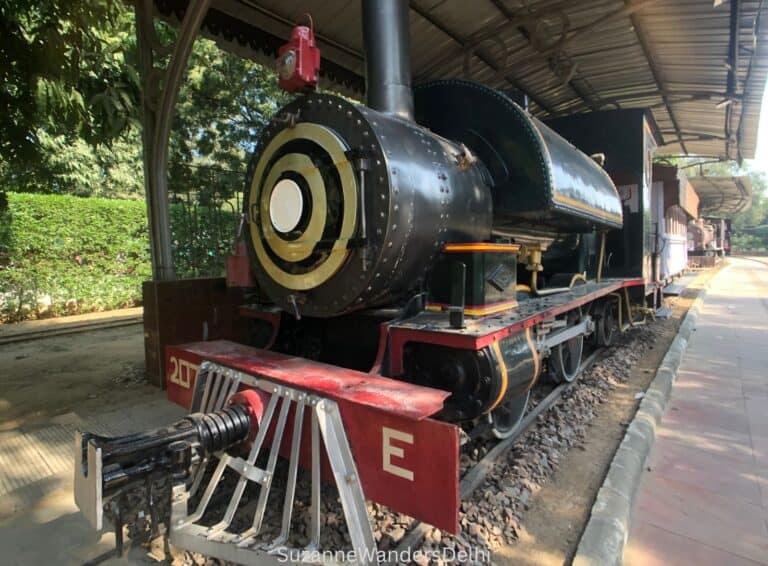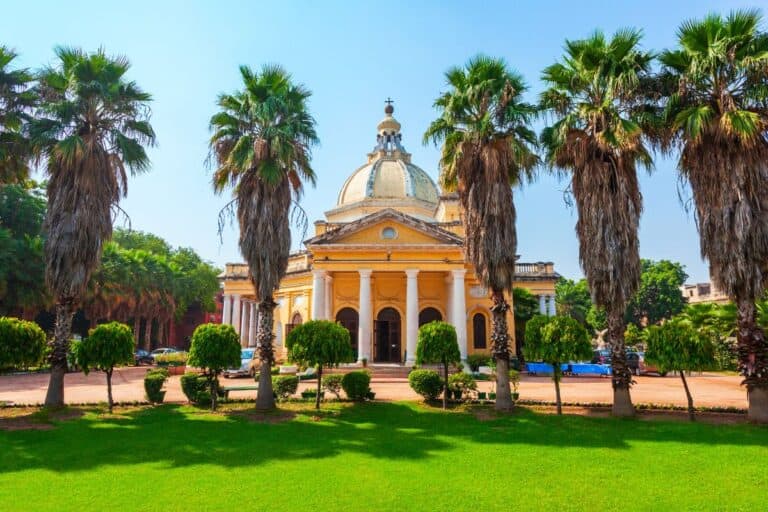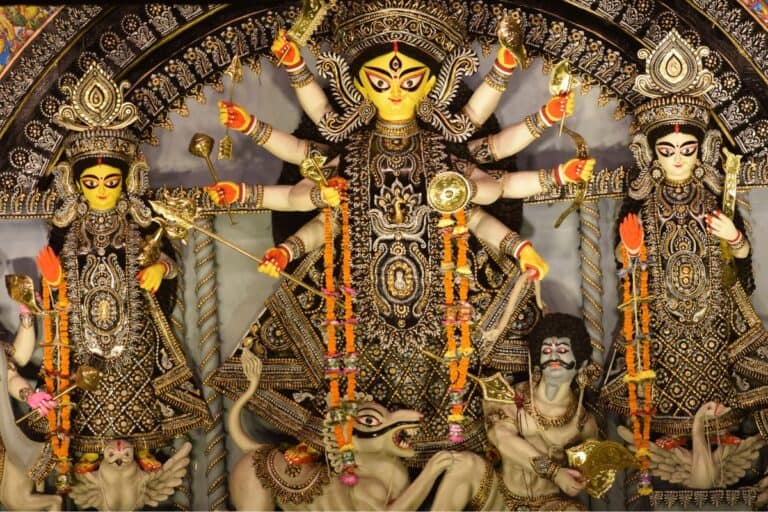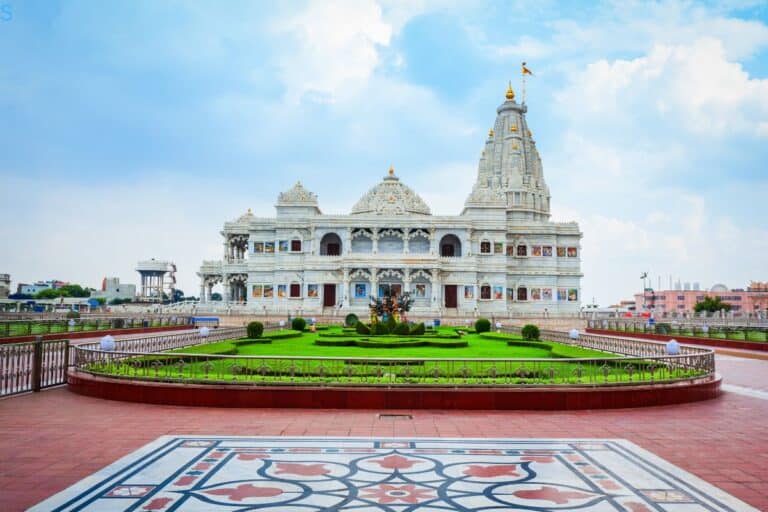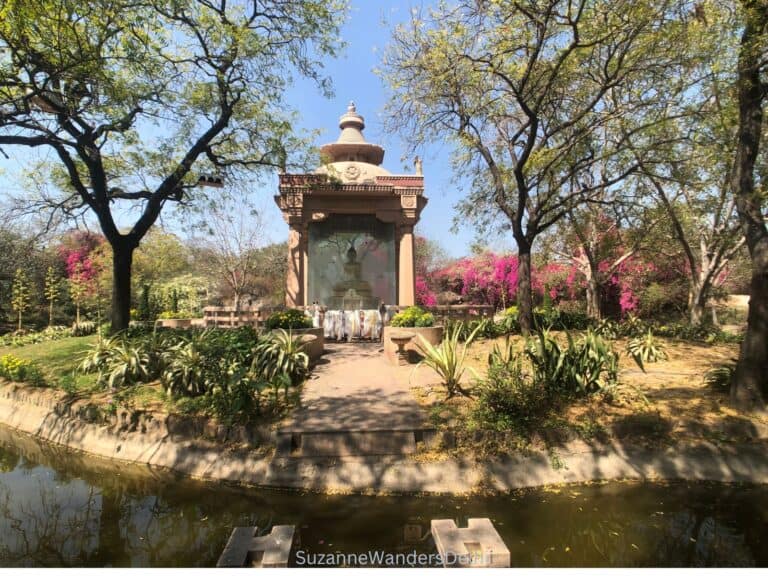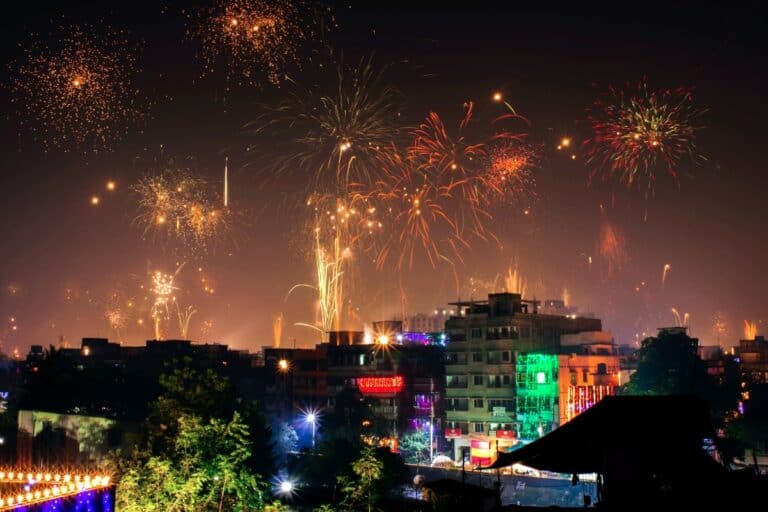21 Famous and Unique Temples in Delhi: An Insider’s Guide

India is a deeply religious country and the capital region has hundreds of temples. These are 21 of the most famous and unique temples in Delhi. I live in Delhi and have visited all of these temples and many, many more. This is my insider’s list of temples you should see.
There are also a number of ashrams for spiritual seekers. Many are open to the public and can be visited for a few hours.
21 Famous and Unique Temples in Delhi
Most temples are named for the Hindu god they are dedicated to, resulting in multiple temples with the same name. To distinguish temples from each other, temple names sometimes include the locality or have a common alternate name, which I have noted.
1. Bahai Lotus Temple
If you have ever flown into Delhi during the day (unfortunately, many international flights arrive at night) you may have seen the Bahai Lotus Temple from the air. Its unique architecture makes it immediately recognizable and one of the most famous temples in Delhi.
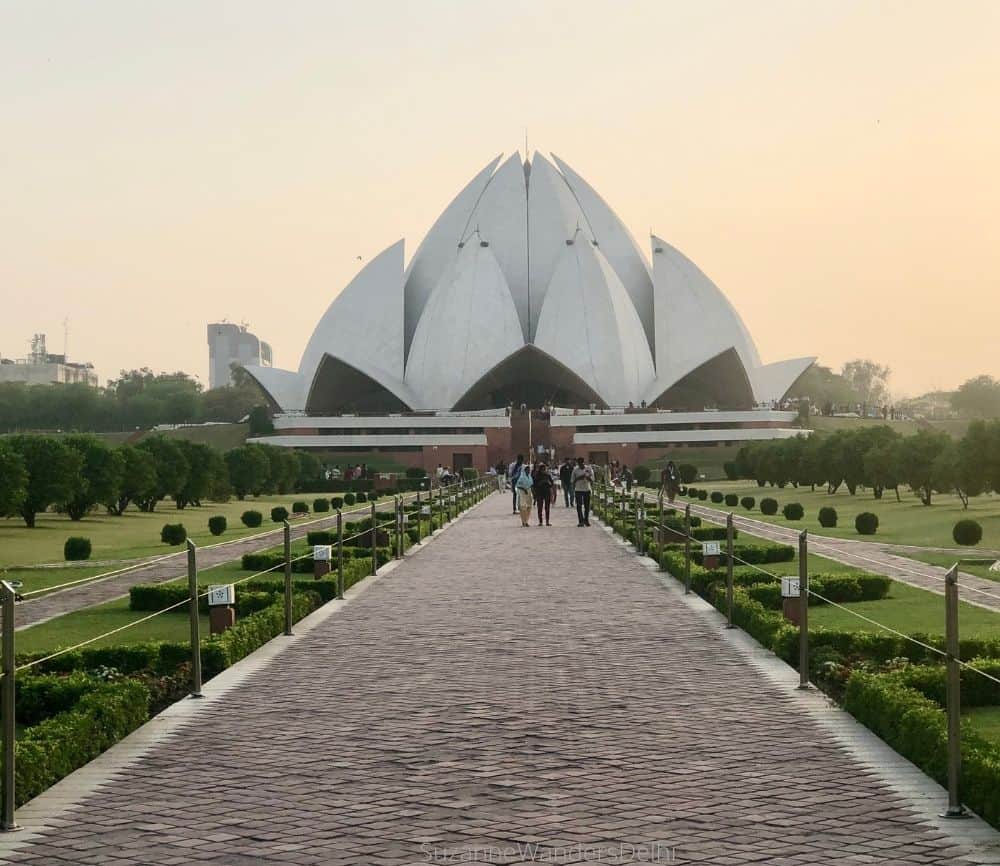
Currently the Lotus Temple is on the UNESCO World Heritage Tentative List. It is one of the most visited religious buildings in the world. According to the Guinness Book of World Records, over 10,000 people visit the temple each day.
Planning and construction began in the 1970s after a Bahai practitioner from Hyderabad donated his life savings for the building of a new temple. The temple opened to the public in 1986.
Architecture of the Lotus Temple
The temple resembles a lotus flower with 27 petals made from Greek marble. Iranian architect Fariborz Sahba created the design and has won numerous awards for it.
The number nine is sacred in the Bahai faith, and because of this the Lotus Temple is nine-sided with three groups of nine petals. Surrounding the temple are nine pools of water and nine gardens. Part of the temple’s electricity consumption is provided by solar panels. It was the first temple in Delhi to use solar power.
Bahais believe in the oneness of God and the unity of all people. There are no deities or religious images inside the prayer hall. It is an expansive and calm space, beautiful in its simplicity.
The temple gets very busy on weekends and holidays. To avoid long lineups the best time to go is a weekday morning. Volunteers are always on hand to keep the queues moving. A bag will be provided to you for your shoes.
Photography is not permitted inside the temple without prior permission.
- Hours: 8:30 am – 5:00 pm, Tuesday to Sunday (closed Monday)
- Nearest Metro Station: Kalkaji Mandir (Magenta line), exit Gates 1 or 2 or Okhla NSIC (Violet line), exit Gate 2
- What Else is Nearby: Sri Sri Parthasarathi Mandir (ISKCON Temple Delhi), Central Market Lajpat Nagar
- Where to Eat: Epicuria Food Mall, Govinda at Sri Sri Parthasarathi Mandir (ISKCON Temple Delhi)
2. Swaminarayan Akshardham
This is one of the largest Hindu temples in the world. Over 7,000 artisans from across India and 3,000 volunteers worked tirelessly to complete the construction in less than five years.
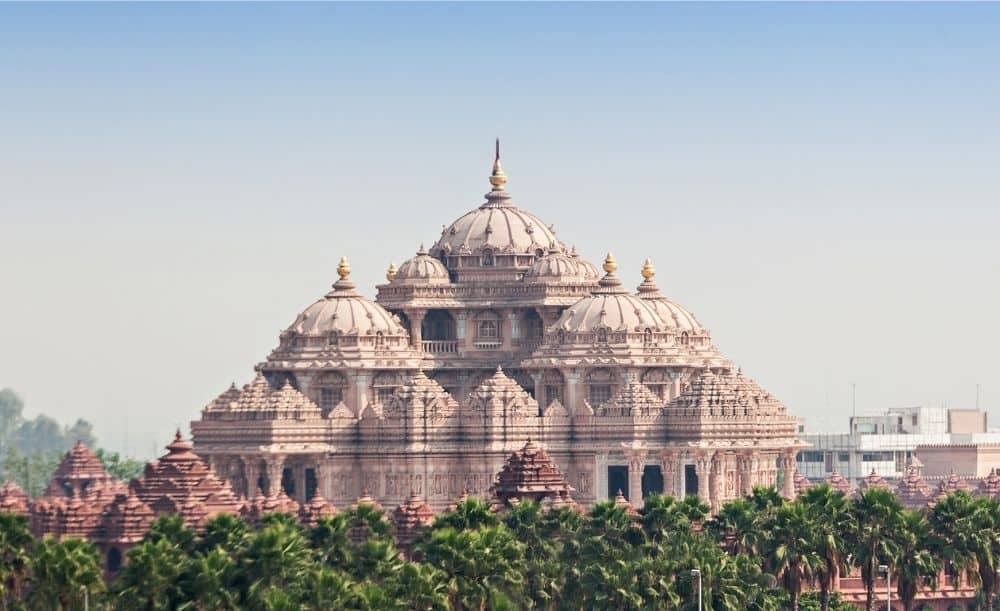
It’s visually stunning inside and out, and one of Delhi’s most famous and unique temples.
The exterior is a pink and white marvel constructed of Italian Carrara marble and Rajasthani sandstone. The interior is truly breathtaking, an intricately carved masterpiece from floor to ceiling. There are several shrines dedicated to the most important Hindu gods and colourful murals depicting the life of Swaminarayan.
Once you arrive at Akshardham you will have to go through security and leave your belongings, including any electronics in the secured storage area. Photography is strictly forbidden once you enter the temple complex.
Akshardham has a strict dress code. You must cover your shoulders, chest and upper arms and bottoms should be below the knee. If your outfit is questionable, don’t worry – the temple has sarongs you can borrow for a small refundable deposit.
Exhibitions at Akshardham
One of the more unusual things at Akshardham are the exhibitions. There are 3D diorama displays, a giant screen movie about the early life of Neelkanth Varni (who later became Swaminarayan), and a 12 minute cultural boat ride.
Between the exhibitions and the children’s playground, it’s quite a child friendly temple. There’s also toilet facilities and drinking water stations throughout the complex.
Although entry to the temple itself is free, there is a fee for the exhibitions: INR 255 for adults, INR 155 for children 4-11, children under 4 are free. This includes all three exhibitions.
Water Show
Every evening there is a hugely popular water and light show which depicts a story from the Kena Upanishad (Hindu holy text). It’s a multimedia event using colour lasers, underwater flames, live actors, music and video projections.
It starts at 7:15 pm and you must arrive at least 30 minutes before or you will not be allowed in. The fee is INR 95 for adults, INR 65 for children 4-11, children under 4 are free.
- Hours: 10:00 am – 7:00 pm, Tuesday to Sunday (closed Monday)
- Nearest Metro Station: Akshardham (Blue line), exit Gate 1
- What Else is Nearby: Worlds of Wonder, Okhla Bird Sanctuary
- Where to Eat: food hall at Akshardham, Haldiram’s at Parsvnath Mall (by the Akshardham metro station)
3. Gurudwara Bangla Sahib
A gurudwara is a Sikh temple and Gurudwara Bangla Sahib is one of the most prominent in Delhi. It is dedicated to the Eighth Sikh Guru, Guru Har Krishnan. I love this gurudwara and often come here. It’s one of Delhi’s most beautiful temples.
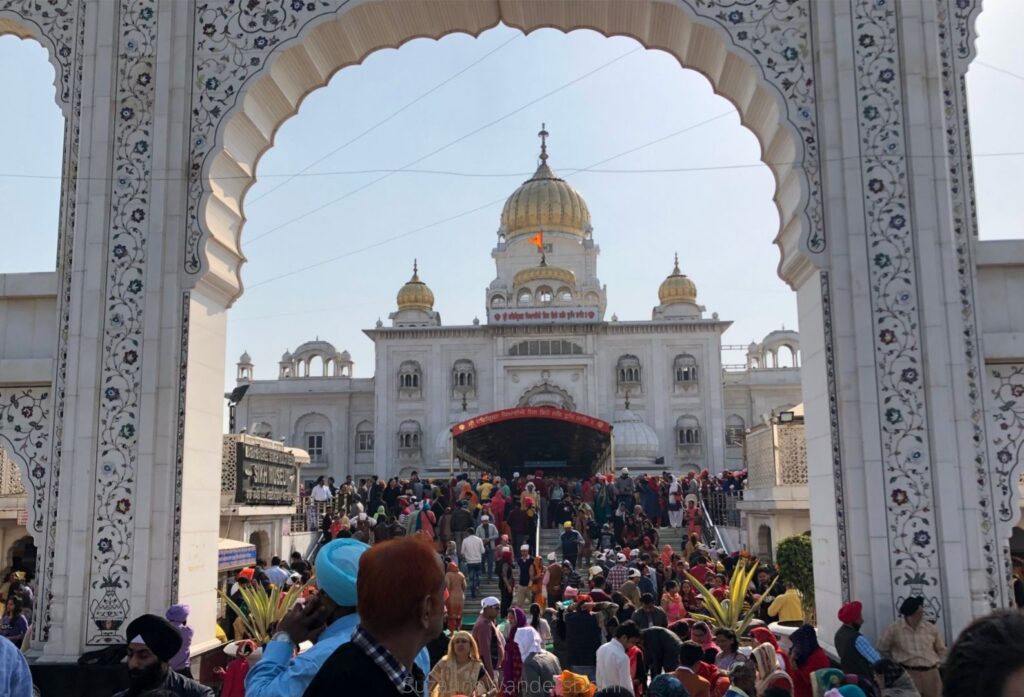
It was once a bungalow owned by a 17th century military ruler named Raja Jai Singh. During the smallpox epidemic Guru Har Krishnan lived there and administered first aid to the sick and gave them water from the well. Later, Guru Har Krishnan died from the disease himself. Raja Jai Singh decided to build the gurudwara in his memory.
Everyone is welcome at the gurudwara and there is plenty to see and experience. Visitors can sit in the prayer hall and listen to live kirtan (devotional music), stroll around the sarovar (holy pond), visit the museum and have langar.
On your way in (or before you leave) stop and get prasad from the window before entering the prayer hall. The gurudwara gives halwa prasad and you can share it with whomever you are with.
Langar
All Sikh gururdwaras serve free vegetarian meals to visitors called langar. Everyone is welcome regardless of faith, nationality, age or sex. Having langar is a special experience, a joyful community meal. Everyone sits on the floor together while volunteers walk up and down the aisles filling trays with food. Everything on the tray must be eaten because the food is considered blessed.
I always try to time my visits to the gurudwara around lunch time so I can have langar. It’s a wonderful, community experience and I urge you try it. This is one of the things that makes Gurudwara Bangla Sahib one of the more famous and unique temples in Delhi.
There are two dining halls at Gurudwara Bangla Sahib and the main one can accommodate 900 people at once. Bangla Sahib feeds 35,000 people a day and that number can triple on special holy days.
Volunteers prepare the food in a massive kitchen. Before the kitchen became automated, I would roll chapattis with the ladies when I visited. Langar is served in the mid afternoon and again in the evening (except Sunday, when it is served all day).
Sundays are especially busy at Gurudwara Bangla Sahib. If some good hearted Indian jostling and rushing for a spot in the langar hall will bother you, avoid this day and come another time.
The Sarovar
One of the most striking features of the gurudwara is the giant water pond, called a sarovar. This is one of the main reasons it is one of the most famous and unique temples in Delhi. Because Guru Har Krishnan healed the sick with this water, the water in the sarovar is believed to have miraculous properties. Sikhs from all over the world come here to collect small bottles of it (called amrit) to take back home.
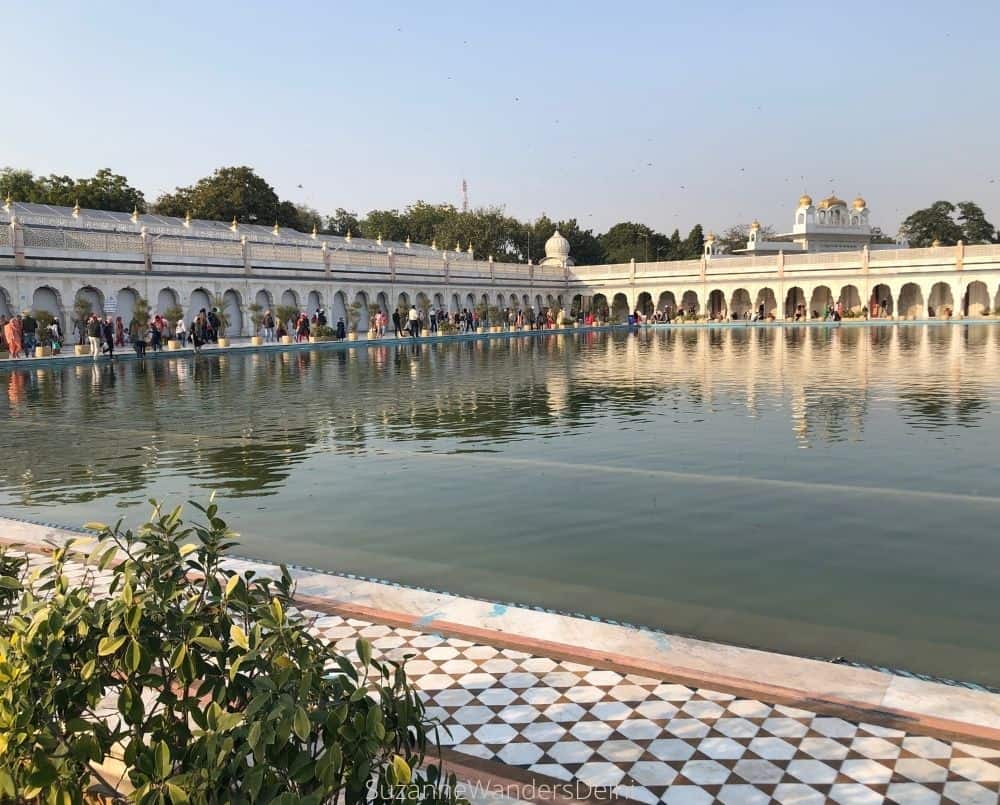
It is traditional to walk around the sarovar (clockwise) when visiting the gurudwara.
Hospital and Diagnostic Centre
The gurudwara has a long history of helping those in need. During Partition in 1947 it was a place of safety and refuge for those fleeing persecution. During the pandemic lockdowns thousands of meals were prepared and delivered to those in need every day.
Today there is a free kidney dialysis hospital which hopes to expand to 1,000 beds. Patients can also get an MRI scan for INR 50. These services are intended for anyone who would otherwise not be able to afford such medical care. Patients and their families can stay at the gurudwara for free and eat in the langar hall during treatments.
Men and women must cover their heads before entering the gurudwara. Kerchiefs are provided if needed. Shoes must be removed and can safely be placed in the shoe storage area. Photography is not permitted in the prayer hall or around the sarovar.
- Hours: open 24/7
- Nearest Metro Station: Shivaji Stadium (Orange line), exit Gate 1
- What Else is Nearby: Sacred Heart Cathedral, Connaught Place, Jantar Mantar
- Where to Eat: langar in one of the dining halls at Gurudwara Bangla Sahib
4. Sankat Mochan Hanuman Mandir (Karol Bagh)
One look and you’ll understand why this is one of the most famous and unique temples in Delhi. It is the 108 foot high orange statue of Lord Hanuman, the Hindu god who is half man and half monkey.
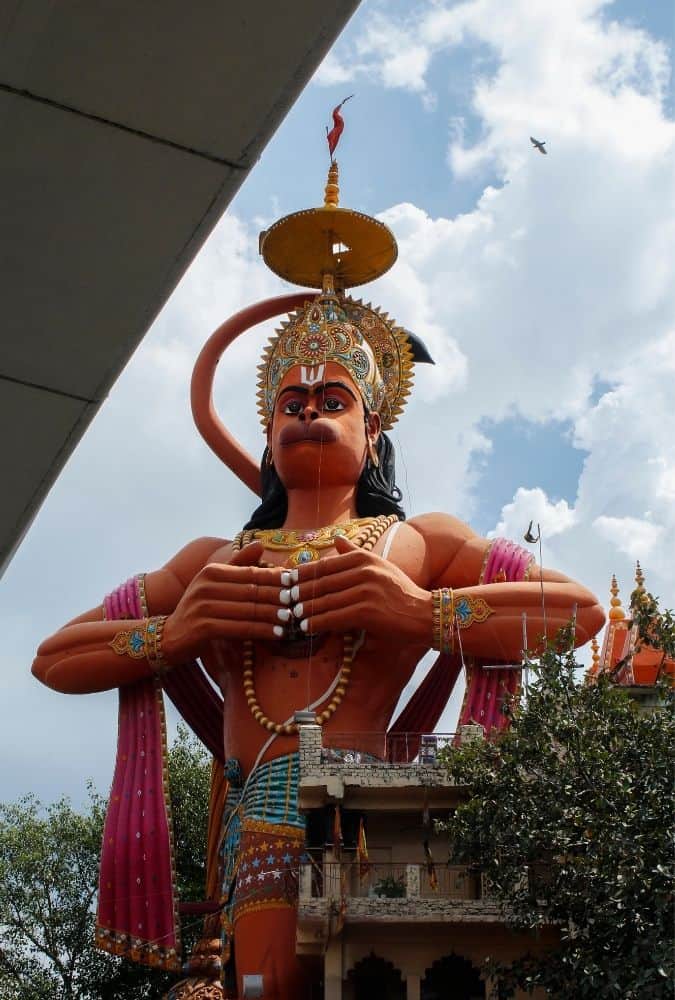
The statue has become an iconic symbol of Delhi, immediately identifying the city. You may have seen this temple from the Delhi metro Blue line – you get a pretty good view of it from there.
The entrance of the temple is the gaping mouth of a monster slain by Hanuman. Inside are several levels, each with various shrines dedicated to different Hindu deities such as Parvati, Lord Ram, Krishna and Ganesha. Each shrine is cared for by a priest who will want to bless you and expect a small donation, about INR 50.
The temple was built by Mahant Nagababa Sevagir Maharaj (Babaji), after having a vision of Lord Hanuman. It took many years to construct, being funded entirely by donations, and was finally complete in 2007.
Apparently the temple was built without proper authorization and is encroaching on city property. For a brief time in 2018 the city considered airlifting the giant Hanuman to another location, but no municipal body was willing to take responsibility. The idea was soon abandoned, and for now the temple remains where it is.
On Tuesday and Saturday at 8:15 am and 8:15 pm a crowd gathers outside to watch as the statue of Hanuman opens his chest to reveal Lord Rama and Sita in his heart. It is quite the spectacle.
Who is Lord Hanuman?
Hanuman is the god who is half man and half monkey. Legend has it that in childhood, Hanuman was hungry and reached for the sun thinking it was a mango. The king of gods, Indra, struck Hanuman with a thunderbolt and he fell to earth dead. His father, who was the god of wind, was so angry he withdrew all the air from earth.
This created much suffering, and as a result Lord Shiva intervened and resuscitated Hanuman. Because Hanuman was wrongly punished by Indra, Lord Shiva and the other gods granted Hanuman super human powers and made him immortal.
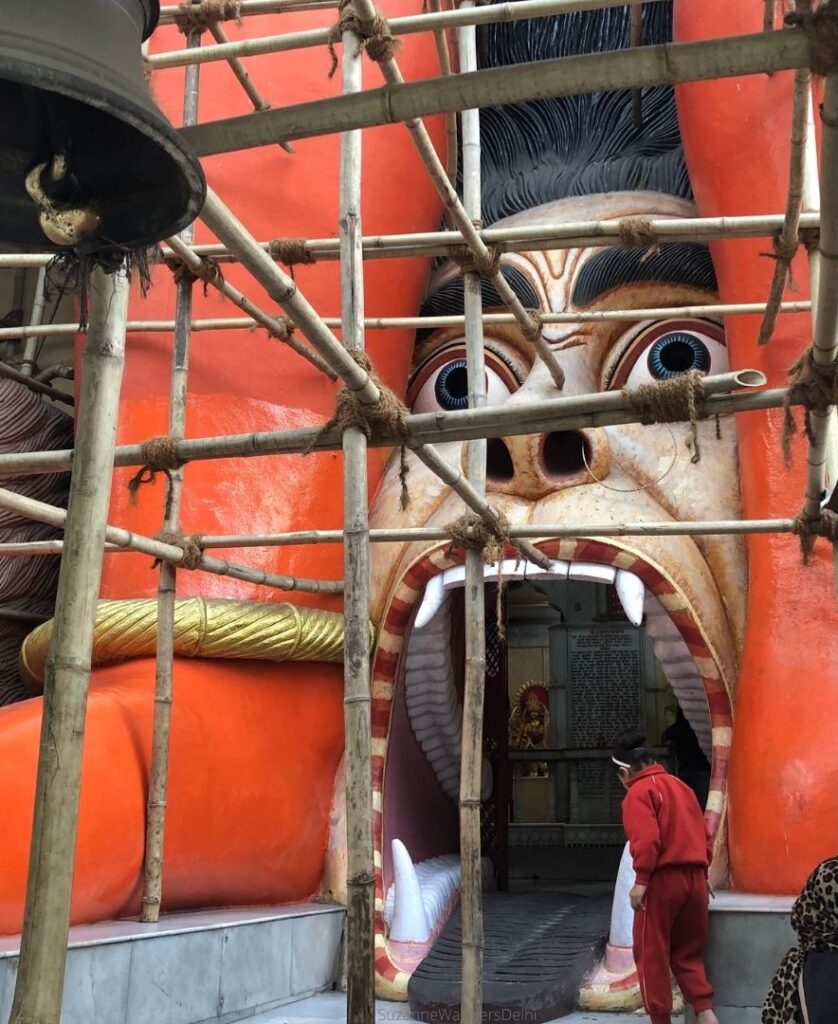
Hanuman is revered for his loyalty, fearlessness and strength. He is an important character in the Ramayana, one of the great epic poems that has deeply influenced Hinduism in India. In the Ramayana, Hanuman rescues the kidnapped Sita from the evil Ravana and returns her to Lord Rama.
There is even a devotional song dedicated to Lord Hanuman, the Hanuman Chalisa. You will often hear it on Tuesdays, the day Hanuman was born and devotees worship him.
Why Lord Hanuman is Orange
This story was shared with me by a devout follower: Lord Hanuman asked Sita why she wore a bindi (the coloured dot Hindu women wear on their forehead). Sita explained it was to show her great love and desire for the protection of Lord Rama. Hanuman then covered his entire body in orange for Lord Rama because his love was so great.
- Hours: 6:00 am – 10:00 pm, daily
- Nearest Metro Station: Jhandewalan (Blue line), exit Gate 3
- What Else is Nearby: Laxminarayan Mandir, Bhuli Bhatiyari Ka Mahal, Karol Bagh Market
- Where to Eat: Roshan di Kulfi, Haldiram’s on Pusa Road
5. Laxminarayan Mandir (Birla Mandir)
When it was built in 1939, Laxminarayan Mandir was the largest Hindu temple in Delhi. Mahatma Gandhi inaugurated the temple under the condition that entry not be restricted to higher caste Hindus; this was at a time when the caste system was still dominant in India (it has now been legally abolished though the effects still linger).
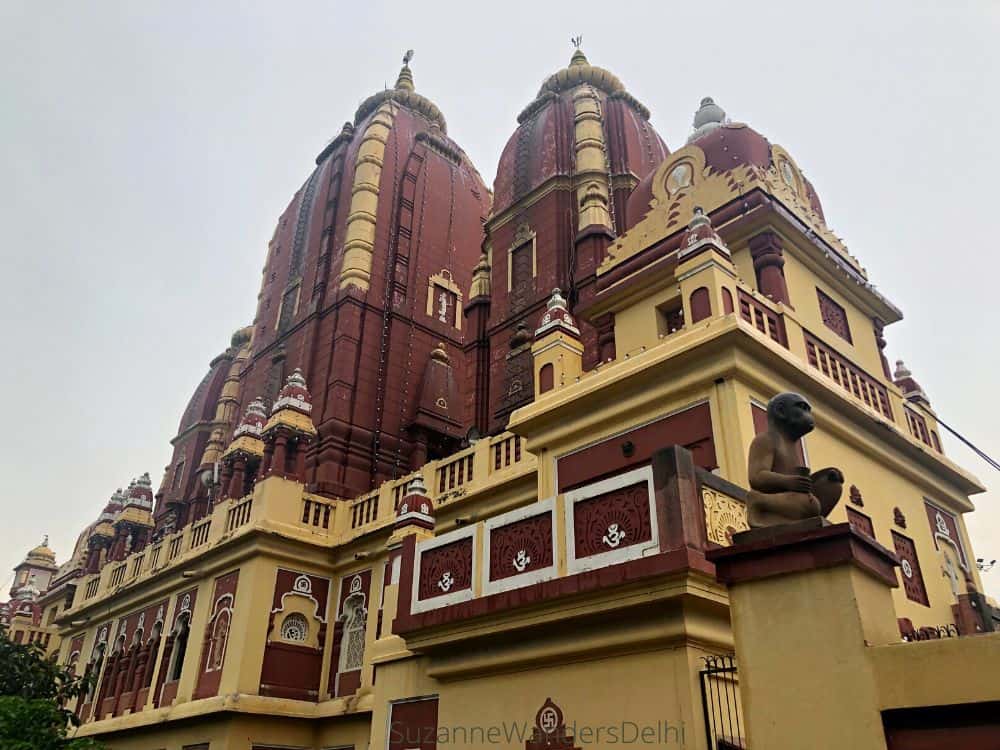
The temple developed a loyal following and remains one of the most prominent Hindu temples in the city. Not many tourists come here, but it is very popular with locals.
Laxminarayan Mandir is dedicated to Lord Vishnu (Narayan) and his consort, Lakshmi. It was the first of a series of temples built by the wealthy industrialist Birla family, commonly called Birla Mandirs.
It’s a beautiful temple decorated with fresco paintings, carvings and marble icons, handcrafted by artisans from one of India’s holiest cities, Varanasi, making it one of the most unique and famous temples in Delhi.
There are extensive gardens with fountains and statues of animals representing different aspects of Hinduism. A Lord Shiva temple with a gaping mouth of a slain monster as the entrance is also on the grounds.
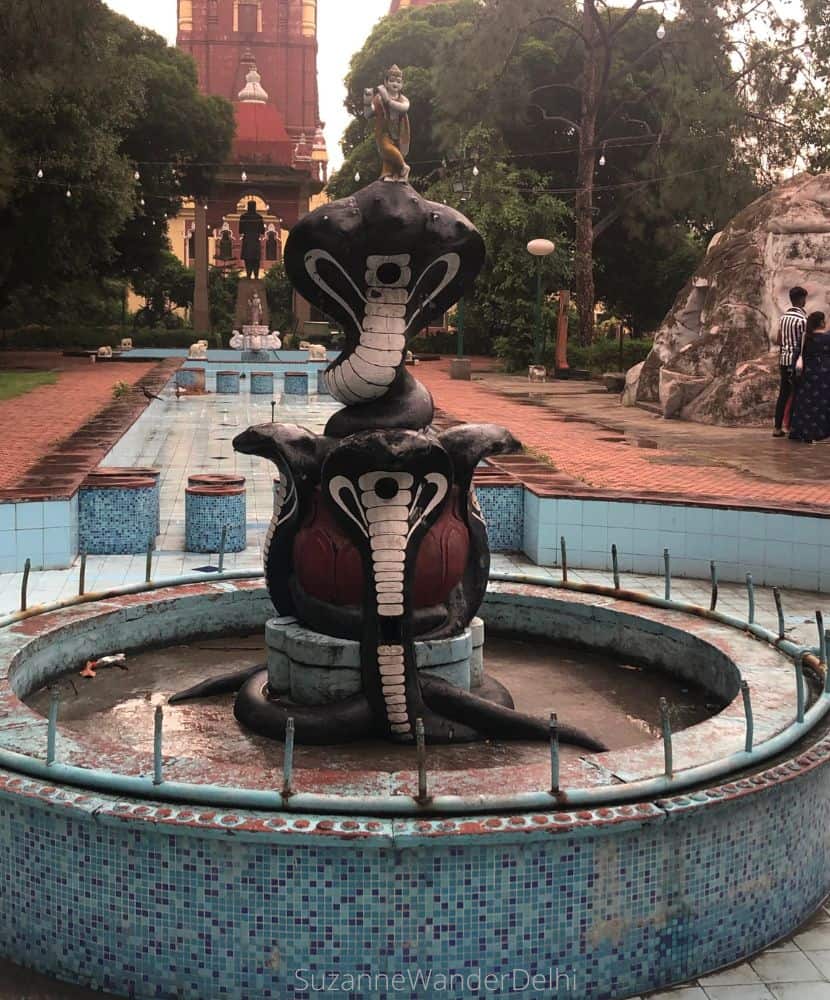
Janmashtami Festival
Laxminaryan Temple is especially known for the festival of Janmashtami, Lord Krishna’s birthday. Thousands visit the temple and devotees line up all the way down the street waiting to enter. Usually Janmashtami is in August or September, but the date changes each year in accordance with the Hindu calendar.
Mobile phones and cameras must be left in the free, secured locker area. Photography is forbidden inside the temple.
- Hours: 4:30 am – 1:30 pm & 2:30 pm – 9:00 pm, daily
- Nearest Metro Station: R K Ashram Marg (Blue line), exit Gate 3
- What Else is Nearby: Sacred Heart Cathedral, Gurudwara Bangla Sahib
- Where to Eat: Coffee Home
6. Sri Sri Parthasarathi Mandir (ISKCON Temple Delhi)
Sri Sri Parthasarathi Mandir (commonly called ISKCON Temple Delhi) is one of the most and unique temples in Delhi for several reasons. Firstly, it is a lively, happy place, not austere at all!
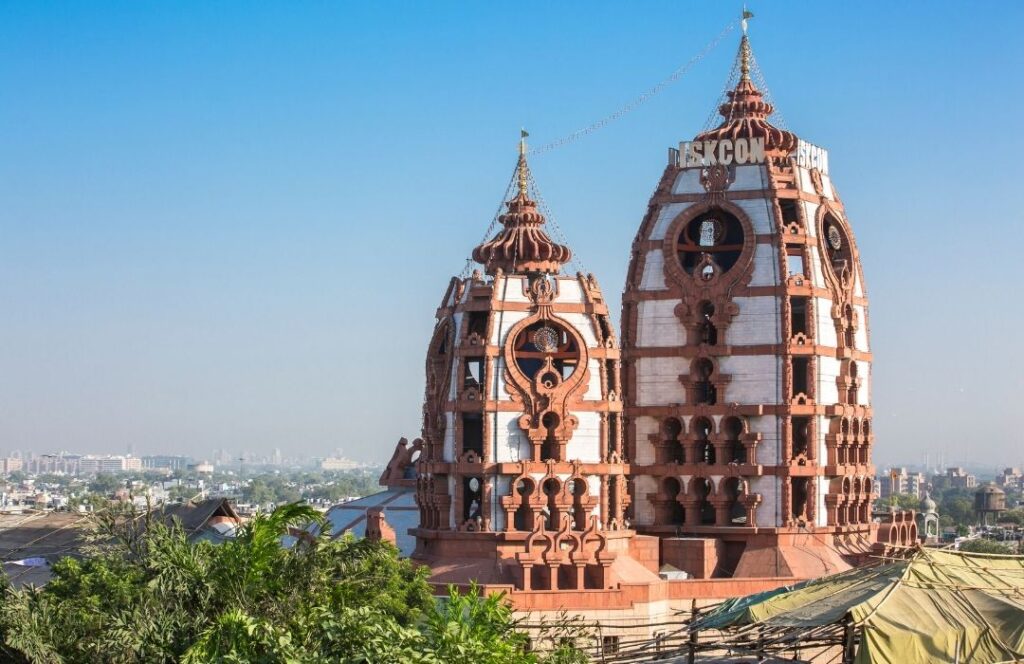
Attending a ritual prayer ceremony is an unforgettable experience with ecstatic devotees clapping, chanting, dancing while priests shower the crowd with rose petals and sacred water. The evening aarti I attended at ISKCON is one of my most memorable Delhi experiences!
The prayer ceremonies (called aartis) are at 7:15 am, 7:30 am, 12:30 pm, 4:15 pm, 7:00 pm and 8:30 pm. The evening ones can be a bit mad, but the crowd is happy and just eager to get as close to the priests as possible, hence the general surge to the front.
What is ISKCON?
ISKCON stands for International Society of Krishna Consciousness and the movement was founded by Srila Prabhupada in the 1960s. Today there are ISKCON centres all over the world. One of the core beliefs is that happiness can be studied and learned in order to obtain a state of permanent contentment.
ISKCON is dedicated to Lord Krishna, the eighth avatar of the supreme god, Vishnu. Krishna is one of the most important Hindu gods and a prominent character in the Indian epic poem the Mahabharata, on which Hindu beliefs are partially based.
Be sure to view the Astounding Bhagavad Gita, an 800 kg book, recognized as the largest principal sacred text ever printed. The Bhagavad Gita is the part of the Maharabata in which Krishna teaches the hero Arjuna how to lead a noble life. The Bhagavad Gita is central to Hindu belief and copies in many different languages are sold at ISKCON Temple Delhi.
- Hours: 4:30 am – 1:00 pm & 4:15 pm – 9:00 pm daily
- Nearest Metro Station: Nehru Place (Violet line), exit Gate 1
- What Else is Nearby: Bahai Lotus Temple, Amar Colony Furniture Market
- Where to Eat: Govinda’s at ISKCON Temple Delhi, Epicuria Food Mall
7. Shri Digambar Jain Lal Mandir & Bird Hospital
Shri Digambar Jain Lal Mandir is the oldest Jain temple in Delhi. The interiors are stunning and it is conveniently located directly across the road from the Red Fort on Chandni Chowk.
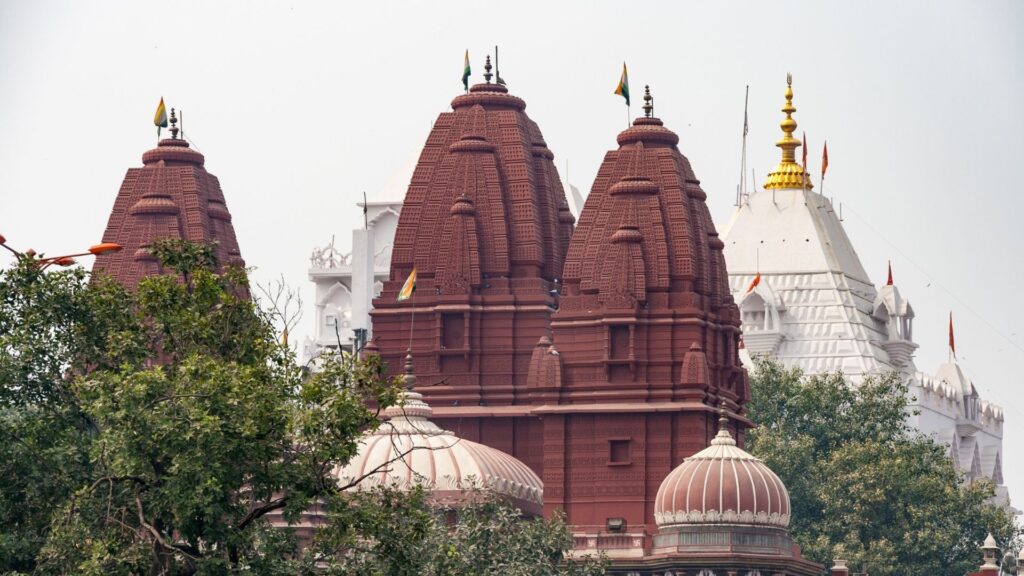
Like the Red Fort, it was built during Shah Jahan’s rule in the 1650s. At the time there was a large Jain community living in the area on land Shah Jahan had given them. When Jain army officers begun to congregate and pray at a tent that had a statue of a Jain deity, Shah Jahan granted permission for the construction of a temple.
Jainism is an ancient Indian religion that believes the path to enlightenment is through non-violence to all living things. Jains are strict vegetarians and do not even eat root vegetables since removing the root kills the plant. They believe in karma and re-incarnation.
Like all temples, shoes must be removed, but at Jain temples all leather items must also be removed (belts, purses, etc.). They can be kept in the storage area. Photography is not allowed inside the temple.
Charity Bird Hospital
One of the most unique features of Shri Digambar Jain Lal Mandir is the bird hospital. The hospital operates completely on donations and does not charge for the treatment of any bird. They care for 15,000 aviary patients a year and anyone can bring an injured bird in, anytime.
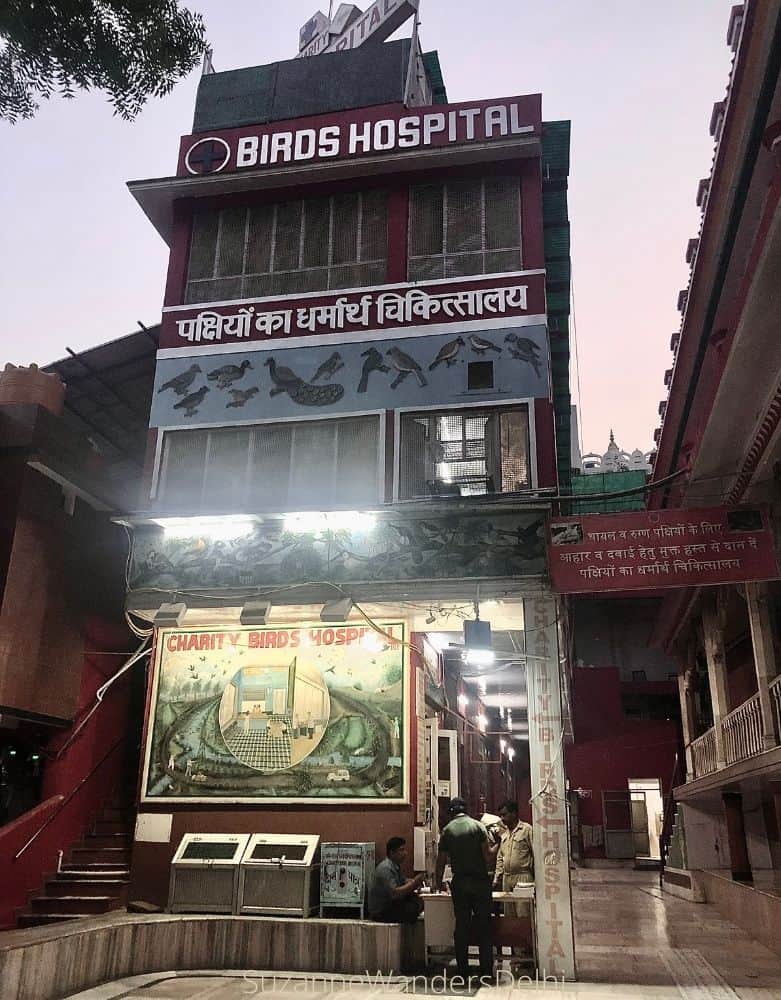
In keeping with Jain beliefs, the birds are fed a vegetarian diet of seeds and vegetables. They are treated, bathed and set free. Squirrels are also treated at the hospital.
The hospital is located on the temple grounds, directly behind the temple. It is open for visitors 8:00 am – 8:00 pm daily. Shoes cannot be worn inside the hospital and there may be bird droppings – you might want to wear a pair of socks you can wash.
- Hours: 3:30 am -11:30 am & 6:00 pm – 9:30 pm daily (summer); 6:00 am – 12:00 pm & 5:30 pm – 9:00 pm daily (winter)
- Nearest Metro Station: Lal Quila (Violet line), exit Gates 1 or 4
- What Else is Nearby: Chandni Chowk, Red Fort (UNESCO), Gurudwara Sis Ganj Sahib
- Where to Eat: Haldiram’s on Chandni Chowk, Kake di Hatti
8. Kururattha-Khemararam (Wat Khmer New Delhi)
Kururattha-Khemararam (aka Wat Khmer New Delhi or Cambodian Monastery of New Delhi) is a small temple tucked away beside the busy Mehrauli-Gurgaon Road. It’s not as famous as it deserves to be, but it is very unique – the only Cambodian mandir out of all the temples in Delhi.
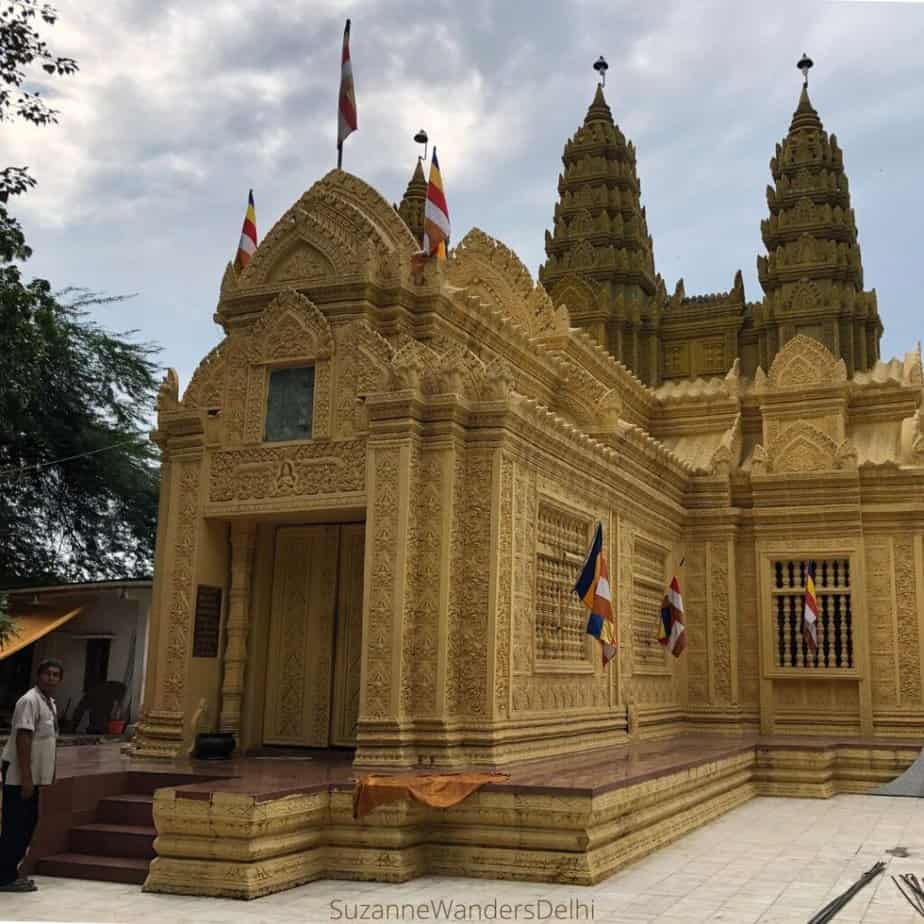
It was established by the Khmer-Hindu Theravada Buddhist Society in 1994 and is maintained by the Khmer Buddhist community.
The exterior is golden and intricately carved in classical Khmer style. The interior is simple but beautiful with a large golden Buddha on a lotus flower.
There is usually a caretaker on duty and if the temple is locked you can ask him to let you inside. He may expect a small tip for this. Remove your shoes before entering.
- Hours: 6:00 am – 12:00 pm & 1:30 pm – 6:00 pm daily
- Nearest Metro Station: Chhattarpur (Yellow line), exit Gate 2
- What Else is Nearby: Dastkar Nature Bazaar, Dhan Mill, Shri Aadya Katyayani Shaktipith Mandir
- Where to Eat: food court in Dastkar Nature Bazaar, Cafe Dori,Bombay Club
9. Shri Aadya Katyayani Shaktipith Mandir (Chhattarpur Temple)
This temple is the most famous in a large complex of temples on Main Mandoli Road in the Chhattarpur neighbourhood of Delhi. It is dedicated to the goddess Shakti (also known as Katyayani).
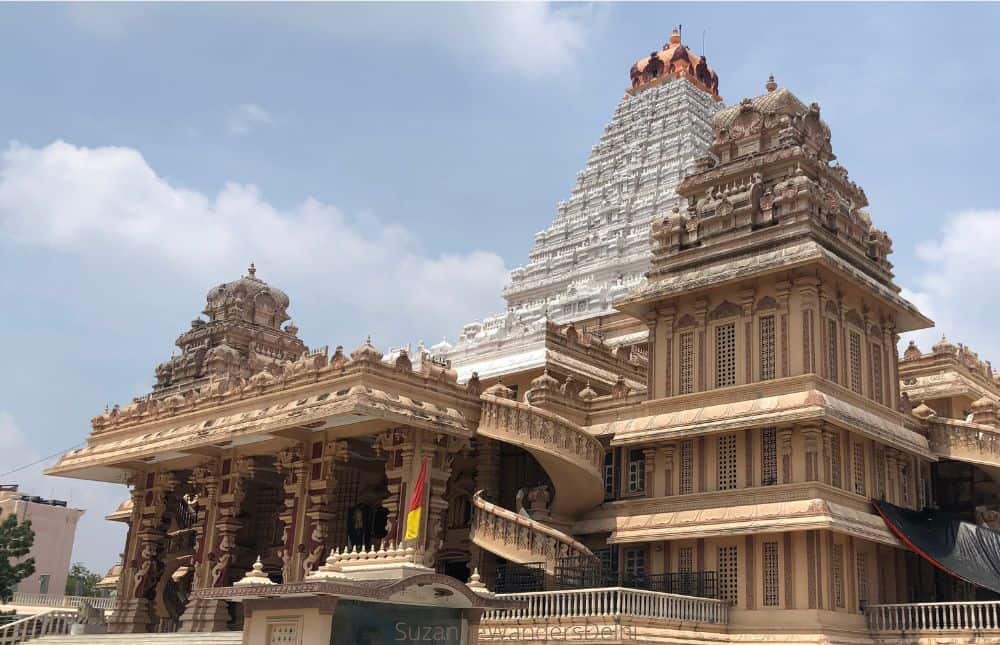
Shakti is central to Hinduism and represents divine female energy. Devotees consider her to be the mother goddess, the sum of all female gods. She has nine avatars, the most well known being Katyayani, Durga, Kali and Parvati, consort of Lord Shiva.
The architecture of Shri Aadya Katyayani Shaktipith Mandir is unique in Delhi, a combination of south and north Indian styles making it one of the more famous temples in Delhi. It is made entirely from marble with intricate carvings and stone lattice work (called jaali). It is one of the largest temples in India.
Inside the temple near the prayer hall is a living room for the goddess, complete with nine chairs, one for each of her nine avatars, as well as a bedroom with a silver bed, dressing table and sword. The interior of the prayer hall is beautiful with an elaborate and brightly painted ceiling.
Aartis (prayer ceremonies) are at 6:30 am and 7:00 pm.
Shaktipith Complex and Markandeya Complex
On one side of the road is the Shaktipith complex (where the main temple, the Shri Aadya Katyayani Shaktipith Mandir, is located) and across the street is the Markandeya complex. It can get confusing because the temples are sometimes identified by their individual names, and sometimes they are all collectively referred to as Chhattarpur Mandir.
If you have time, it is worth exploring the two complexes. On the Shakitpith side there are shrines devoted to different Hindu gods and a chariot used during the Navratri festivals.
Across the street in the Markandeya complex are a Hanuman temple, the Nageshwal temple, Baba Nagpala Temple where Baba Nagpal Ji’s mortal remains are kept, a huge Lord Shiva trident and gardens.
The Founder of Chhattarpur Temple, Baba Nagpal Ji
There is also a museum dedicated to Baba Nagpal Ji, the founder and force behind the construction of Chhattarpur Temple. Baba Nagpal Ji became a lifelong follower of Shakti when he was brought to a temple devoted to the Mother Goddess after losing his parents as a child.
Baba Nagpal Ji was revered for his tireless work to help the needy and known to donate to different religious communities, including mosques. This earned him the respect from followers of all faiths. To this day the Shaktipith complex runs several schools and a medical diagnostic centre, all free for those in need.
Navratri Festivals
The Shaktipith temple complex is especially busy during the two main Navratri seasons when thousands of devotees visit daily.
During this time the temple stays open around the clock. The lines are massive and devotees wait hours to get into the main temple. There are four Navratris each year but it is the two main ones that attract enormous crowds. I would avoid going to the temple during Navratri unless you are an ardent follower of Katyayani.
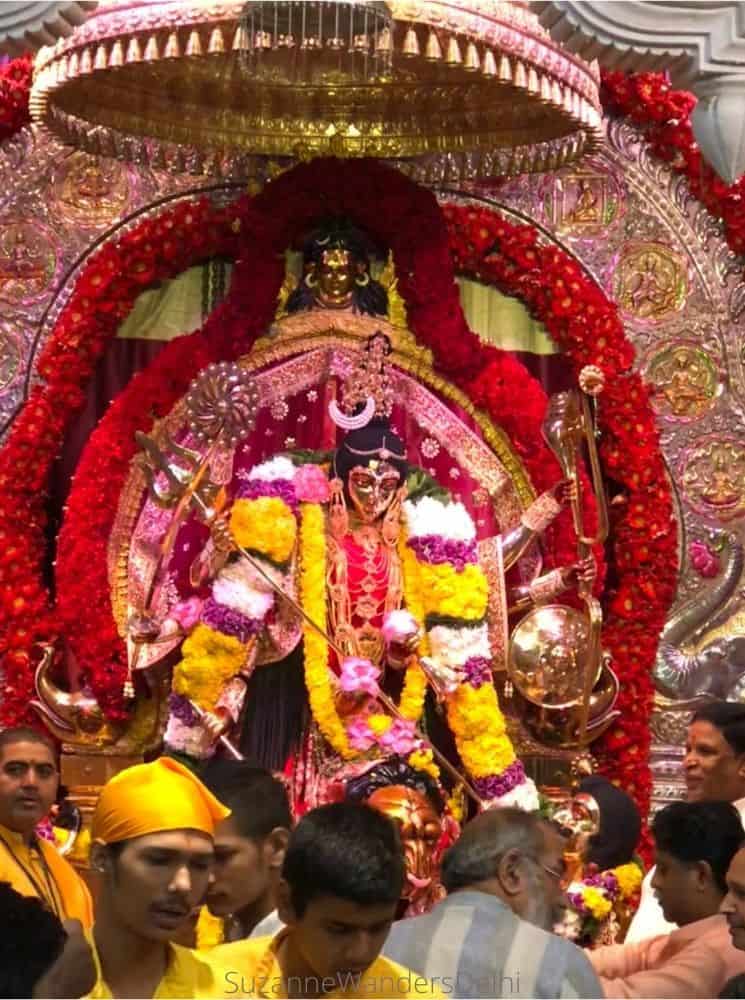
Navratri dates are based on the Hindu calendar, so they change yearly but are generally in March/April and September/October. It is nine days long and a special diet is observed; you will often see restaurants advertising a Navratri menu or thali plate during these times.
During Navratri, the image of Katyayani Devi is placed in the main hall, near the prayer hall. She is always elaborately dressed and garlanded in fresh flowers. Thousands will walk past her and seek her blessings.
The temple also provides langar (free community meal) to about a thousand visitors a day during Navratris and other festival days in its massive dining hall. The food is prepared and served by volunteers.
- Hours: 6:00 am – 10:00 pm
- Nearest Metro Station: Chhattarpur (Yellow line), exit Gate 2
- What Else is Nearby: Dastkar Nature Bazaar, Dhan Mill, Kururattha-Khemararam
- Where to Eat: Cafe Dori, CAARA at Ogaan
10. Tibetan Monastery (Majnu Ka Tilla)
Majnu ka Tilla is known as Delhi’s Little Tibet and it has two famous and unique Tibetan Buddhist temples which are side by side in a quiet courtyard.
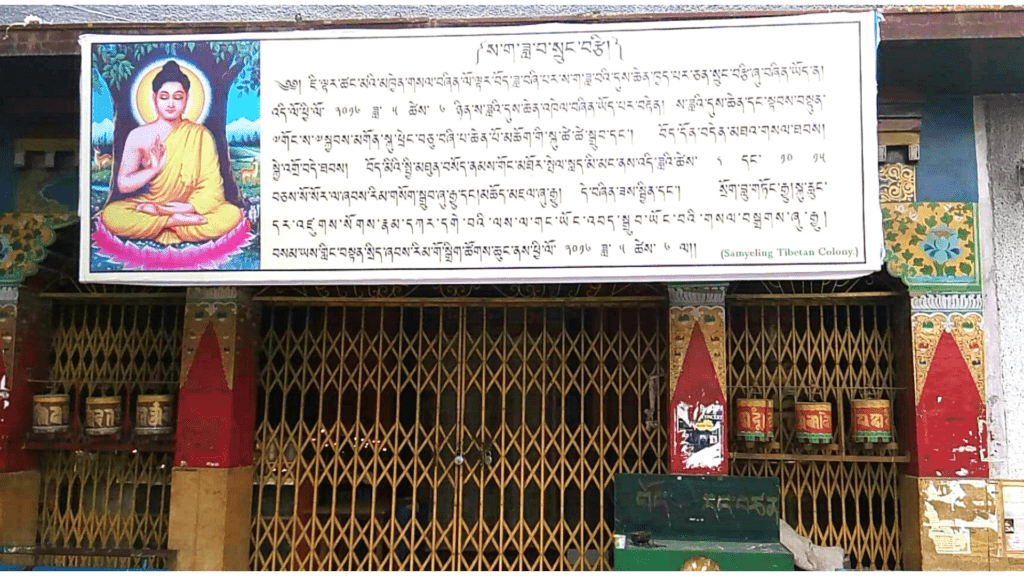
Tibetans started coming to Delhi in 1959 after the Dalai Lama was exiled to Dharamshala in northern India. Refugees settled in this area on land that was allotted to them by the government. Today the area is home to about 3,500 second generation Tibetans.
The temples are both styled in traditional Tibetan fashion with images of the Buddha, prayer wheels, butter carvings, sacred texts, candles and holy images. Monks wander around quietly and chant prayers.
The temples are peaceful and serene, tucked away at the end of a courtyard in an otherwise busy market area.
Be sure to try the Tibetan street food laphing while here; there’s a lady with a stall in the courtyard just outside the temples. Laphing is a delicious vegetarian noodle-like pancake snack; I always get the dry version (as opposed to the soup).
- Hours: 6:00 am – 8:00 pm daily
- Nearest Metro Station: Vidhan Sabha (Yellow line), exit Gate 2
- What Else is Nearby: Majnu ka Tilla, Gurudwara Majnu ka Tilla
- Where to Eat: The Himalayan Rooftop, AMA Cafe
11. Shri Neelanchal Seva Sangh (Shri Jagannath Mandir)
This is a small but well known south Indian temple very near Hauz Khas Village. I often visit this temple whenever I’m in the area.
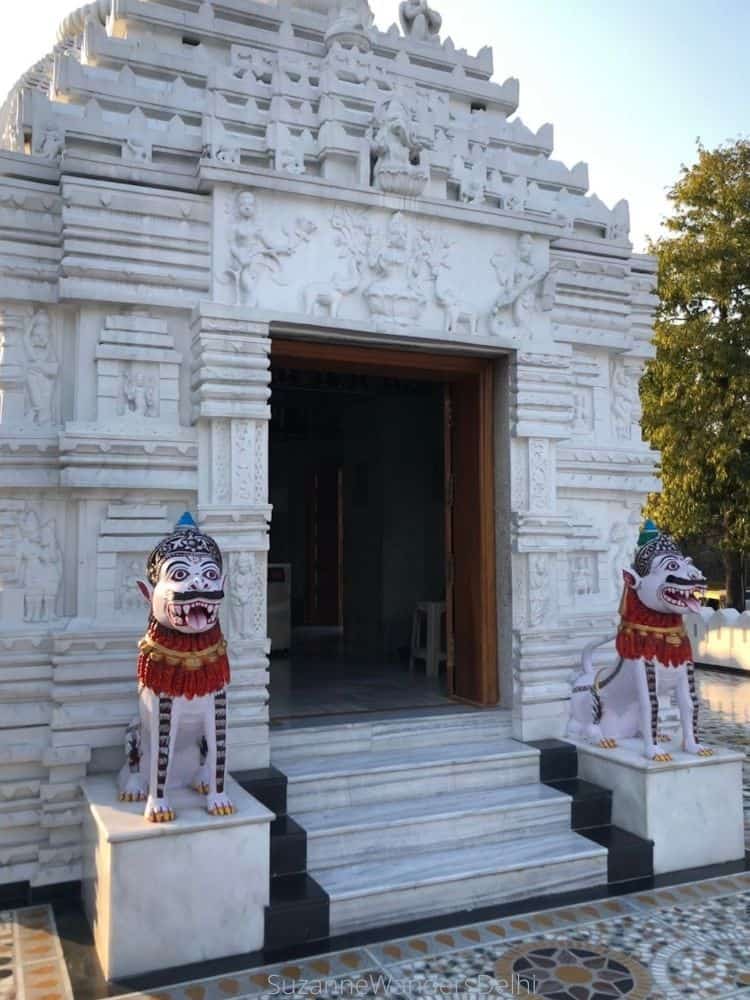
It was built for the local Odisha community in 1969 and is dedicated to the Hindu god Jagannath. Jagannath is considered an avatar of Vishnu and worshipped as a form of Lord Krishna in south India.
Its formal name is Shri Neelanchal Seva Sangh, but it is more commonly known as the Jagannath Mandir in Hauz Khas. The temple is actually several small temples, each with their own deities whose clothing and jewellery are changed daily.
Shri Jagannath Mandir is famous for its Rathyatra festival which is in June or July (the date is based on the Hindu calendar, so it changes yearly).
During Rathyatra, the statues of Lord Jagannath (aka Lord Krishna) and his brother and sister, Lord Balabhadra and Goddess Subhadra, are taken from the temple and placed in grand chariots for a ceremonial procession through the streets.
It attracts large crowds but it’s an unforgettable sight. At this time the temple itself is especially spectacular, completely decorated in marigolds.
- Hours: 4:30 am – 1:30 pm & 4:00 pm – 10:00 pm (March to September); 5:30 am – 1:30 pm & 4:00 pm – 9:00 pm (October to February)
- Nearest Metro Station: Green Park (Yellow line), exit Gate 3
- What Else is Nearby: Hauz Khas Village, Hauz Khas Fort, Deer Park
- Where to Eat: Hauz Khas Social, A2B, Evergreen Sweet House
12. Kalkaji Mandir
Kalkaji Mandir is one of the oldest and most revered Hindu temples in Delhi. Part of the current structure was built in 1764 but it’s believed the origins of the temple go back to the Mahabharata (the epic Indian poem on which much of Hinduism is based), about 5,000 years ago.
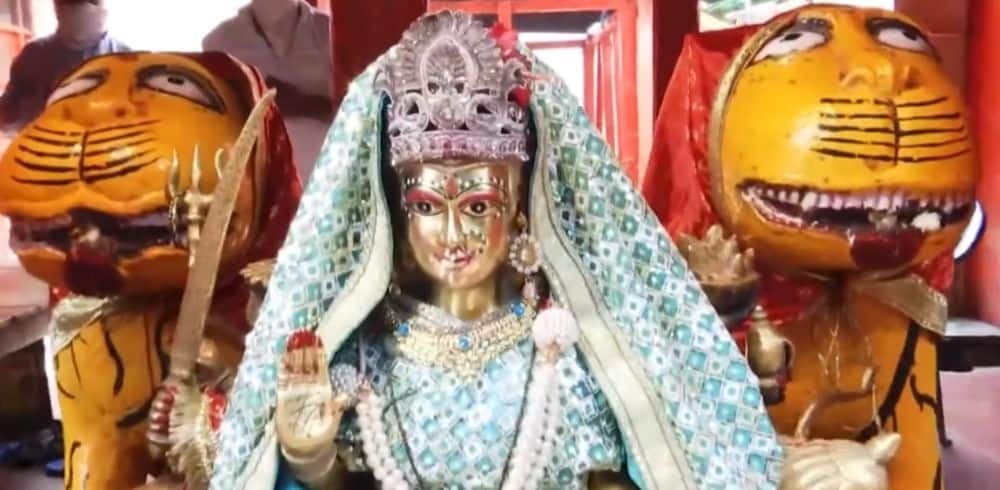
It holds a special place in many devotees’ hearts, as the Goddess Kalkaji appeared and settled at the site of the present temple. During the time of the Mahabharata, Lord Krishna worshipped the goddess here. This is why Kalkaji Mandir is one of the most unique and famous temples in Delhi.
Every morning prior to the first aarti (prayer ceremony), the deity is lovingly bathed in milk and dressed.
Stalls selling images and statues of gods, bangles and a variety of religious offerings line the walkway leading to the temple. During the nine day Navratri festivals, the temple takes on a carnival atmosphere and the entire roadway is full of vendors and hawkers selling snacks, toys and cotton candy.
This temple can get busy, especially during the Navratri festivals and is known for pick pockets. Keep a close watch on your personal items.
- Hours: 4:00 am – 11:30 pm daily
- Nearest Metro Station: Kalkaji Mandir (Violet line), exit Gates 1 or 2
- What Else is Nearby: Bahai Lotus Temple, Nehru Place Market
- Where to Eat: Epicuria Food Mall
13. Pracheen Hanuman Mandir
Pracheen Hanuman Mandir is one of the oldest Hanuman temples in India. Like Kalkaji Mandir above, it is also believed to go back to the time of the Indian epic, the Mahabharata, making it one of the most famous and unique temples in Delhi.
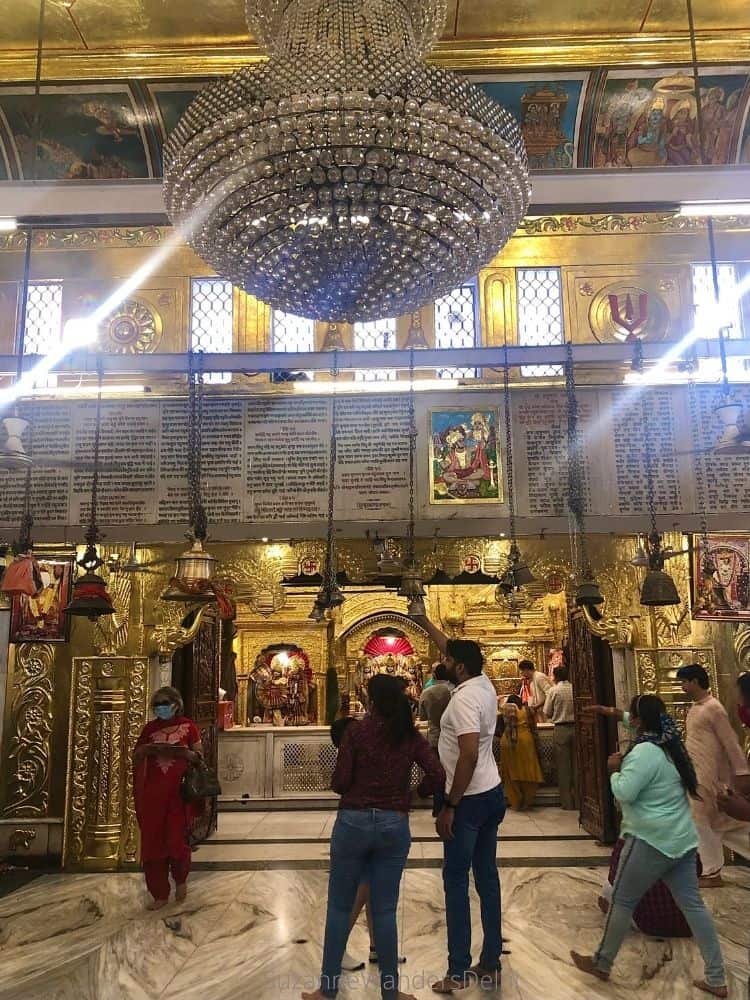
The temple is dedicated to the god Hanuman who is revered for his strength, courage and unwavering devotion to Lord Rama. Devotees worship Lord Hanuman to gain peace, happiness, success and courage.
The temple will be extra busy on Tuesday as it is the most auspicious day to worship Lord Hanuman.
The current structure was built by Maharaja Man Singh between 1540 and 1614, during the reign of the Mughal ruler Akbar. It was then rebuilt by Maharaja Jai Singh in 1724.
One of the reasons this temple is so revered is the image of Lord Hanuman is self-manifested (called a Swayambhuhu), meaning it was not made, but appeared spiritually.
Hanuman is a central character in the Indian epic the Ramayana, and scenes from the epic are painted on the ceiling of the main hall. In the Ramayana, Hanuman rescues Lord Rama’s consort Sita from the demon Ravana and safely returns her to Rama.
- Hours: 5:00 am – 11:00 pm daily except Tuesday and Saturday when it is open almost 24 hours (aartis are at 5:30 am daily, except on Tuesday and Saturday when they are at 5:00 am)
- Nearest Metro Station: Rajiv Chowk (Blue and Yellow lines), exit Gate 7
- What Else is Nearby: Jantar Mantar, Connaught Place, State Emporiums on Baba Kharak Singh Road
- Where to Eat: Saravana Bhavan, Coffee Home
14. Kali Mandir (Chittaranjan Park)
More than a temple, the Kali Mandir serves as a cultural centre for the Bengali community of Delhi. It is located in an area called Chittaranjan Park (locally referred to as CR Park), which has a large Bengali population.
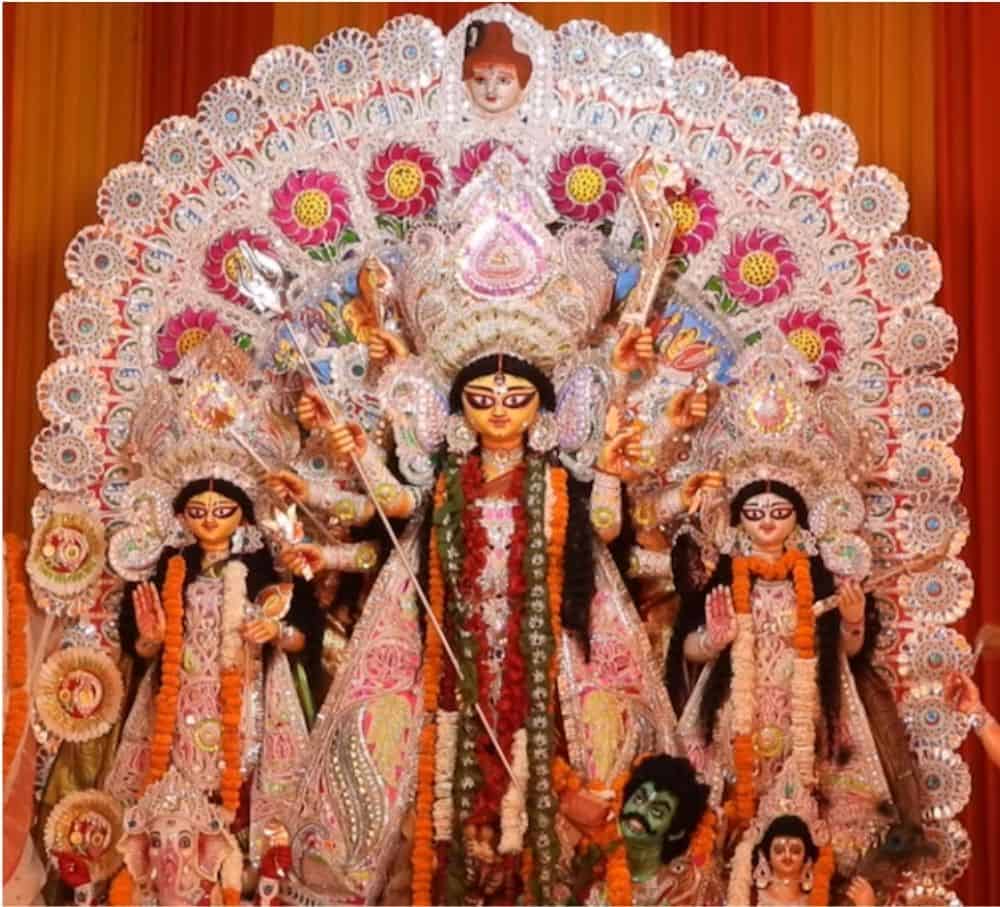
The largest shrine is the one dedicated to the goddess Kali. It is flanked by shrines devoted to Lord Shiva and Radha Krishna on each side. The shrines are very close to each other and connected by a covered walkway so you can easily visit all three.
The complex is built in typical terracotta Bengali style and the shrines are covered in beautiful terracotta carvings.
Kali Mandir hosts a number of cultural and religious events during the year, but the biggest of them all is Durga Puja. In fact, this is the best place in Delhi to celebrate Durga Puja.
Every evening at 7:00 pm (except Monday) there is a 15 minute musical fountain show. Photography is not permitted in the temple.
Durga Puja Festival
Durga Puja is the biggest festival in Bengal (a state in eastern India), which celebrates good over evil as the goddess Durga kills the evil demon king Mahishasura. It’s in September or October every year, based on the Hindu calendar, and lasts for 10 days. It coincides with the fall Navratri festival. Hindus believe this is when the goddess comes to her earthly abode to bless her devotees.
During Durga Puja the queues at Kali Mandir can be very long, sometimes an hour or more. The temple is beautifully lit up and there are special pandals (displays of deities) set up.
The festival is widely celebrated in CR Park (where the Kali Mandir is located) by the Bengali community. There are several festival locations in the neighbourhood, such as Nabapalli Ground in Pocket 40, the Co-operative Ground in Block J and the Mela Ground. You can easily take a rickshaw between these locations and the temple. There will be music, pandals, food and all kinds of vendors.
For how to celebrate this festival, read my guide to Durga Puja in Delhi.
- Hours: 5:00 am – 12:30 pm & 4:00 pm – 10:00 pm (April to October); 5:45 – 1:00 pm & 4:00 pm – 9:00 pm (November to March)
- Nearest Metro Station: Greater Kailash (Magenta line), exit Gates 2 or 3
- What Else is Nearby: Kalkaji Mandir, Bahai Lotus Temple
- Where to Eat: Sagar Ratna, Carnatic Cafe
15. Uttara Swami Malai Mandir (R K Puram)
Often simply referred to as Malai Mandir, this is a south Indian temple dedicated to Lord Swaminatha. It gets its name from the Tamil world for hill, ‘malai’ since the temple is located at the top of a hill.
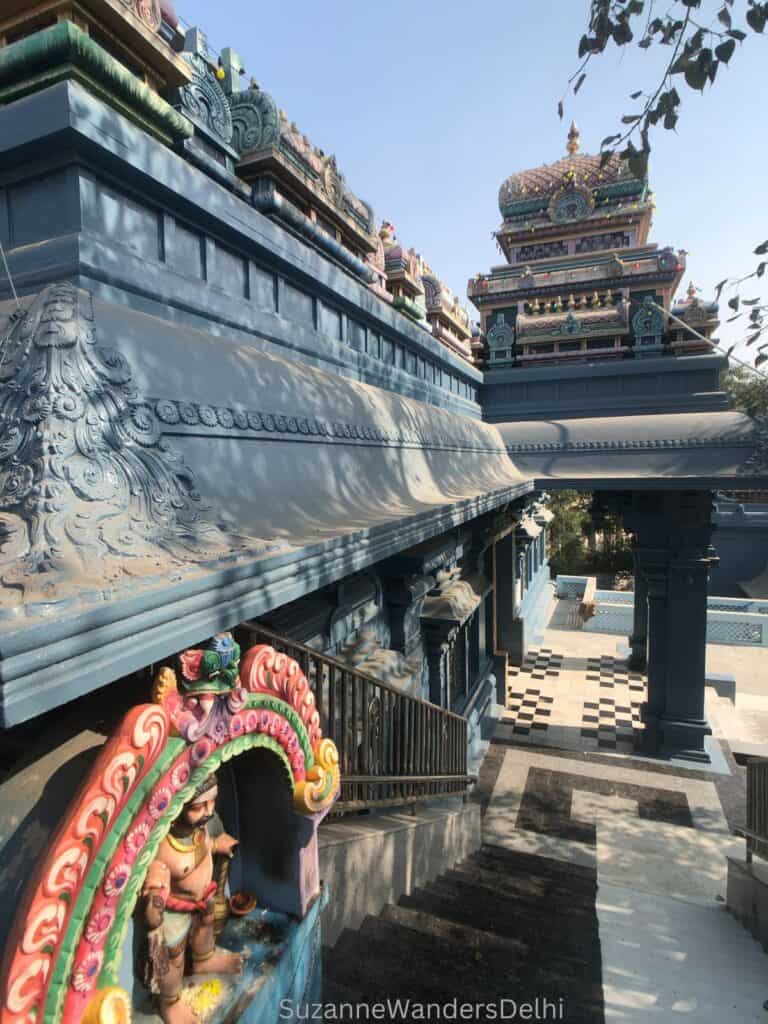
Construction began in 1961 after Lord Swaminatha appeared in a devotee’s dream, indicating a small, secluded hill that he wished for his earthly home.
The temple is built entirely of granite stones without the use of cement or mortar. Some of the stones are massive and weigh between 3-4 tons. An adhesive of lime, sand and molasses was used to fill the crevices between stones. Architecturally, it resembles the Chola style temples of Tamil Nadu, India.
Who is Lord Swaminatha?
Lord Swaminatha is the son of Lord Shiva and Parvati (he was then named Kartikeya). After imparting the meaning of the word ‘om’ to Lord Shiva, Parvati re-named him Swaminatha, which means ‘the guru of Lord Shiva.’
Peacocks are kept by the temple because the peacock is said to be the vehicle of Lord Swaminatha.
- Hours: 6:30 am – 11:00 am & 5:00 pm – 9:00 pm (Monday to Thursday), 6:30 am – 12:00 pm & 5:30 pm – 9:00 pm (Friday to Sunday)
- Nearest Metro Station: Munirka (Magenta line), exit Gate 1
- What Else is Nearby: National Rail Museum, Wazirpur Gumbad Complex
- Where to Eat: Leo’s Artisan Pizza, Perch Wine & Coffee Bar, Greenr Cafe
16. Ladakh Buddhist Vihara
This peaceful monastery is tucked away in Monastery Market beside one of Delhi’s busiest and noisiest areas near ISBT (Inter State Bus Terminal). It was built in 1963 to support the Tibetan and Ladakhi (Ladakh is a state in northern India) communities that settled nearby.
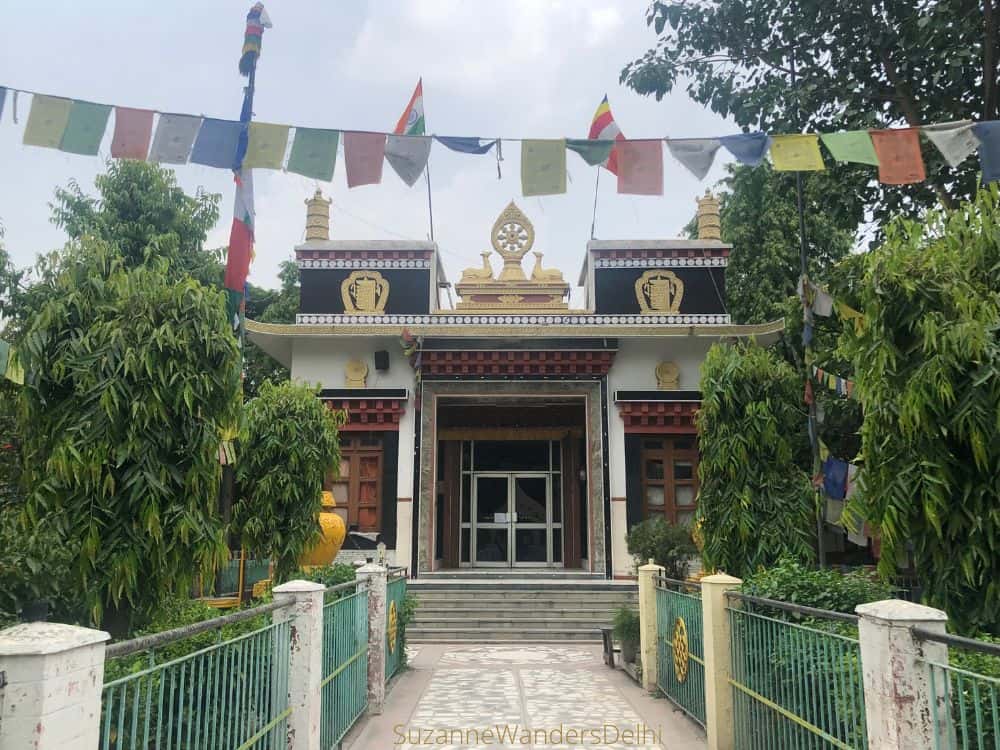
The temple interior is decorated with paintings and thangkas (painted religious scrolls) depicting the life and teachings of Buddha with a large, beautiful golden Buddha in the centre.
A long row of Tibetan prayer wheels line the exterior wall of the temple and a cabinet of butter lamps sits just outside for devotees to light. Lighting a butter lamp symbolizes extinguishing the inner darkness of ignorance and lighting the inner light of wisdom.
Monastery Market
Beside the monastery is a fantastic market for winter wear like jackets, gloves, scarves, socks and sweaters. Prices are very reasonable and there are lots of vendors. You will not find authentic branded items here, but a lot of ‘first copy’ knock-offs, which is supposedly a better quality knock-off.
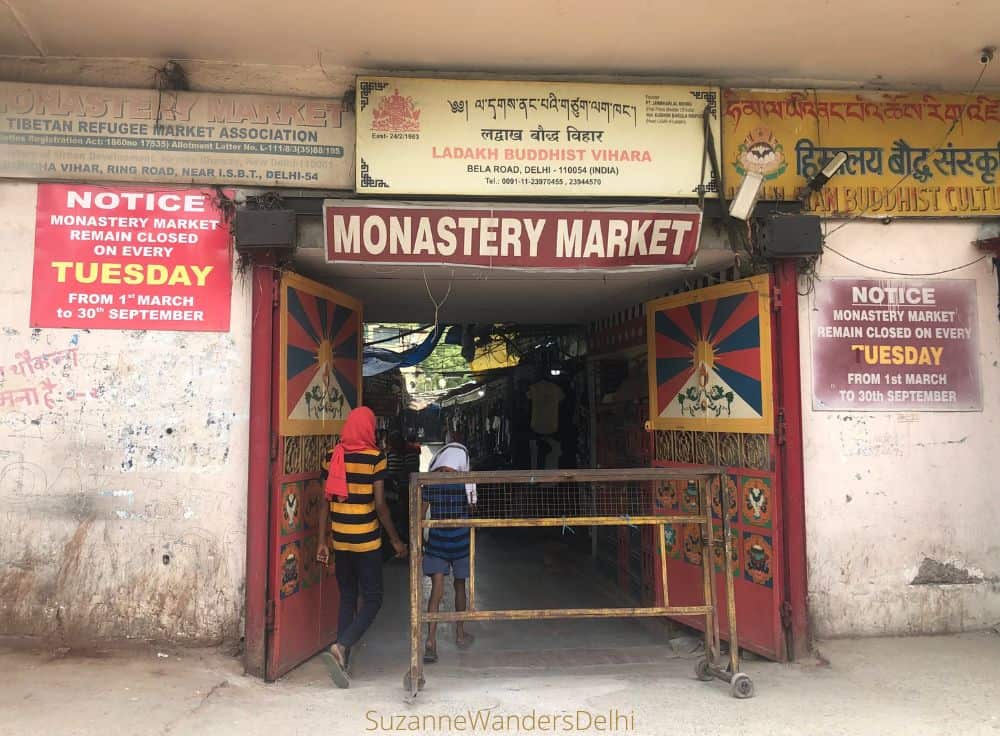
You can also find backpacks, shoes, electronic items (though quality may be questionable) and Tibetan items. There’s also a good Ladakhi restaurant called Open Air Ladakh Restaurant (also called Leh Zakhang on Google) in the market. The market is closed on Tuesday.
- Hours: 8:00 am – 7:00 pm daily
- Nearest Metro Station: Civil Lines (Yellow line), exit Gate 3
- What Else is Nearby: Monastery Market, Qudsia Bagh
- Where to Eat: Open Air Ladakh Restaurant in Monastery Market (also called Leh Zakhang on Google), or Garden Terrace Restaurant at one of Delhi’s best hotels, the Maidens Hotel.
17. Jhandewalan Mandir
Jhandewalan Mandir is one of the oldest and most important Hindu temples dedicated to the all powerful goddess Durga. It is situated near Karol Bagh, a busy central Delhi neighbourhood.
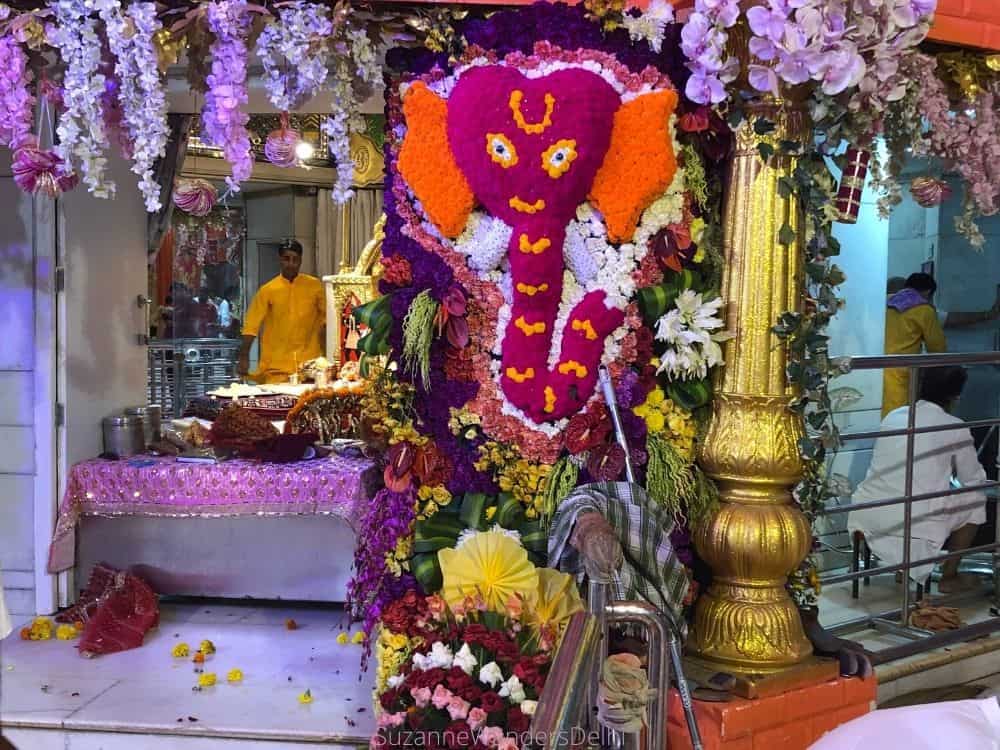
The temple was built in the 18th century after Badri Das, a cloth merchant, discovered a carving of the goddess and a stone lingam while digging. At the time, this area was covered in forest. Das built the temple on the same spot and installed a large prayer flag. Jhandewala means ‘place of the flag.’
The original idol discovered by Das is stored in a sanctum below the temple, making it a very unique and famous temple in Delhi.
Visiting During Navratri
During the Navratri festivals, the deities are dressed in elaborate clothing and accessories, and the temple becomes awash in flowers and lights. It’s the most flower adorned temple I have ever seen and a spectacular sight. This is one of the reasons it is one of the most unique and famous temples in Delhi.
Besides the shrine which holds the idols of Durga and her manifestations as Saraswati and Kali, there are shrines of Lord Shiva and other Hindu gods.
If you go to Jhandewalan Mandir during Navratri, expect long queues and crowds. Visiting a Durga temple (or Kali or Shakti temple, any manifestation of the supreme female goddess) during Navratri can be an intense but rewarding experience. The energy and spiritual devotion of the crowd is inspiring and many temples take on a festival-like atmosphere with hawkers, vendors and street food sellers setting up nearby.
- Hours: 5:30 am – 9:30 pm daily (temple may close for several hours during the afternoon); during Navratri it is open 24/7
- Nearest Metro Station: R K Ashram Marg (Blue line), exit Gate 1
- What Else is Nearby: Karol Bagh Market, Gaffar Market
- Where to Eat Nearby: Roshan di Kulfi, Haldiram’s on Pusa Road
18. Mangal Mahadev Birla Kanan (Shivaji Murti)
Mangal Mahadev Birla Kanan Temple is dedicated to Lord Shiva, in this case referred to as Mahadev which means ‘great god.’
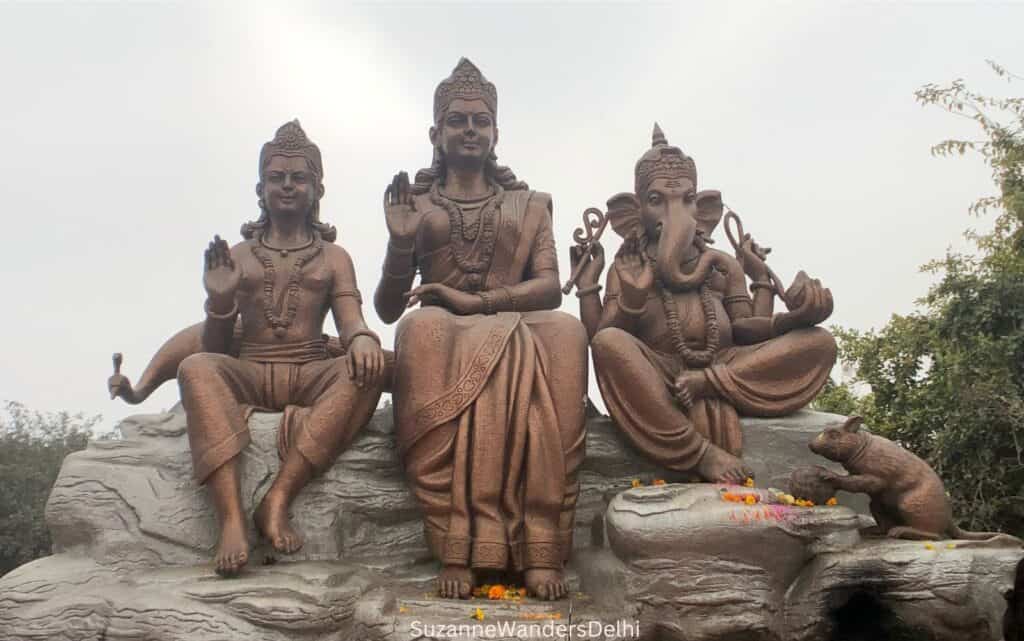
This is one of the most unique and famous temples in Delhi because it resembles a park more than a traditional temple. Set in well maintained gardens on approximately 20 acres of land, it is a series of large statues of Hindu gods, some as tall as 100 feet. In fact, if you have traveled on the main highway between Delhi and Gurugram, you have probably seen the enormous statue of Lord Shiva from the highway.
It’s located in Gurugram, a south western suburb of Delhi, and was built in 1994. There’s a small shop as you enter which sells items for puja (worship) and other spiritual things like prayer books.
Even though the complex is outdoors and resembles a park, it is still a temple and shoes must be removed.
The Indira Gandhi International Airport is directly across the street and it’s a great place for plane watching – they fly in very low over the temple.
- Hours: 6:00 am – 10:00 pm daily
- Nearest Metro Station: Delhi Aerocity (Orange/Airport Express line) – you will need to take an Uber or auto rickshaw from here
- What Else is Nearby: Aerocity, Ambience Mall Vasant Kunj, Indian Air Force Museum
- Where to Eat: Farzi Cafe, the Beer Cafe
19. Gurudwara Sis Ganj Sahib
This gurudwara (Sikh temple) holds a special place in the hearts of the Sikh community. The shrine is on the exact spot that the ninth Sikh Guru, Guru Tegh Bahadur, was beheaded in 1675 on the order of the Mughal ruler Aurangzeb. The gurudwara takes its name from the Punjabi word for head, ‘sis.’
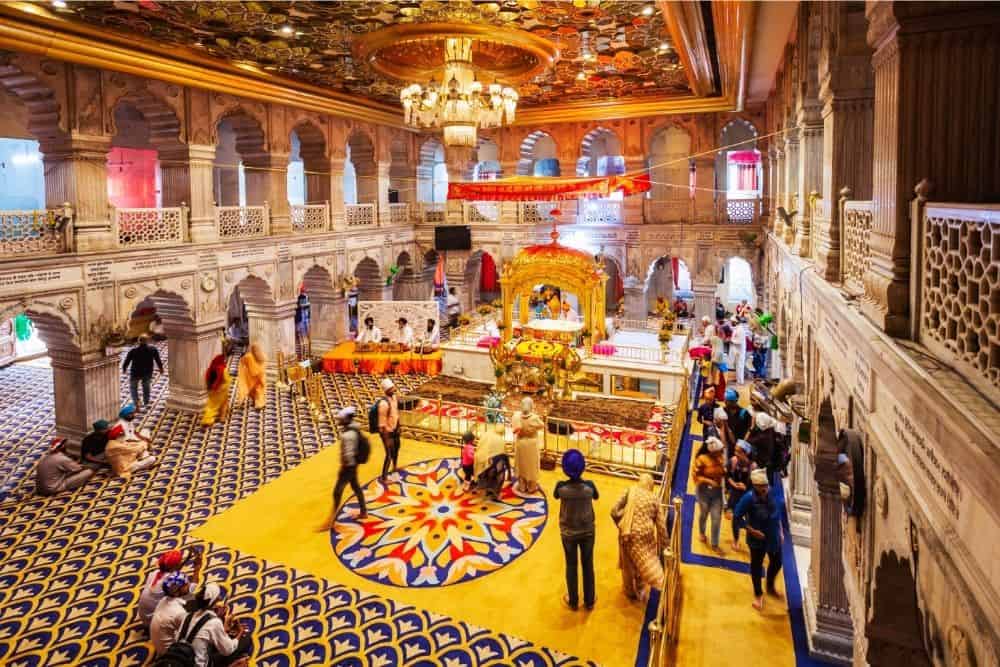
The gurudwara was first constructed in 1783 as a small shrine to commemorate the martyrdom site of Guru Tegh Bahadur. It was later expanded in 1930 to the building it is today.
Delhi’s Blackest Night
Legend has it that after Guru Tegh Bahadur was executed, an unusual storm completely blackened the Delhi skies, temporarily blinding people. This enabled one of the Gurus disciples, Lakhi Shah Vanjara, to steal the Guru’s body before it could be quartered and exposed to public view.
To avoid the attention a cremation would cause, Lakhi Shah Vanjara burnt his house down with the Guru’s body inside to properly cremate it.
Another brave disciple took the Guru’s head and cremated it in the Punjab region, where a gurudwara by the same name, Sis Ganj, was later built on the exact site of the cremation.
The interior of the gurudwara is beautiful and offers a peaceful retreat from the madness of Chandni Chowk just outside. I like to sit and listen to the live kirtan (sacred hymns); it’s very relaxing. The last time I was there, a monitor showed the English translation of the hymns as they were sung.
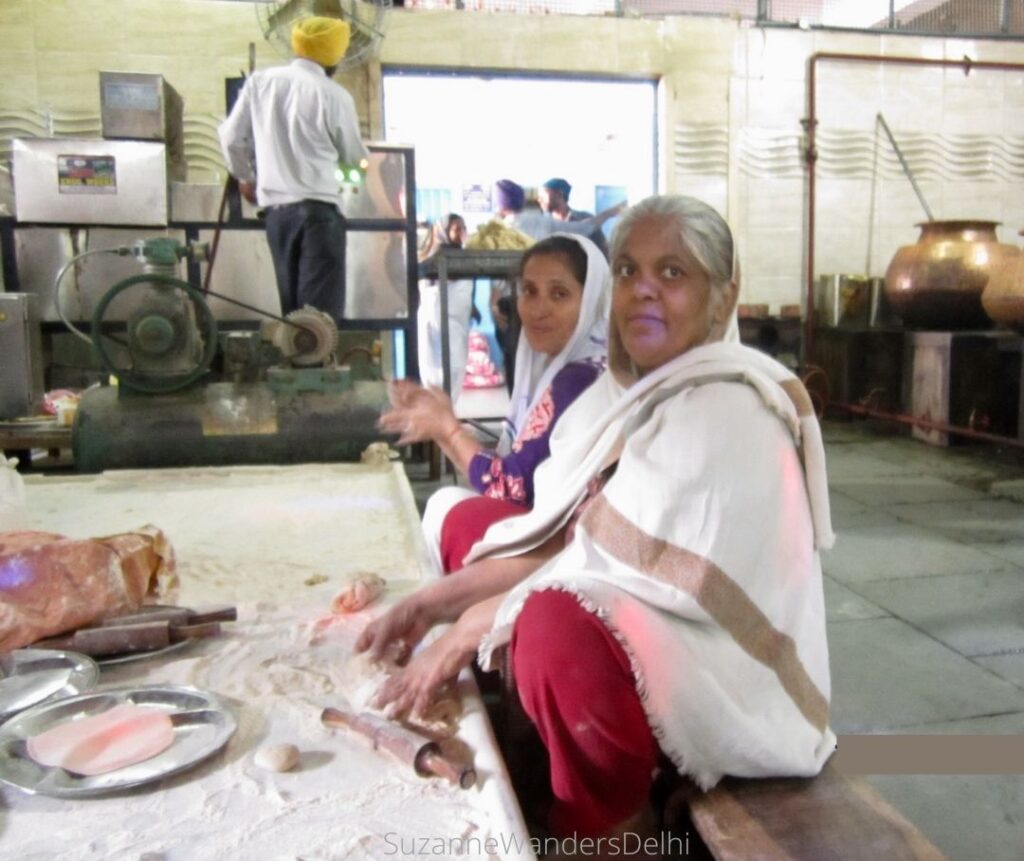
As in all gurudwaras, men and women must remove shoes and cover their heads before entering the temple. The gurudwara always has kerchiefs outside for this purpose. When sitting in the prayer hall, do not sit with your feet facing or pointing toward the holy book (the Granth Sahib) at the front.
- Hours: 24/7
- Nearest Metro Station: Chandni Chowk (Yellow line), exit Gate 1
- What Else is Nearby: Chandni Chowk, Red Fort (UNESCO), Shri Digambar Jain Lal Mandir & Bird Hospital
- Where to Eat: langar at the gurudwara, Kunwarji Raj Kumar Bhatura Junction
20. Sai Baba Mandir (Lodhi Road)
There are different Sai Baba temples throughout Delhi (I had one just around the corner from my old place) but this one on Lodhi Road is one of the oldest and busiest.
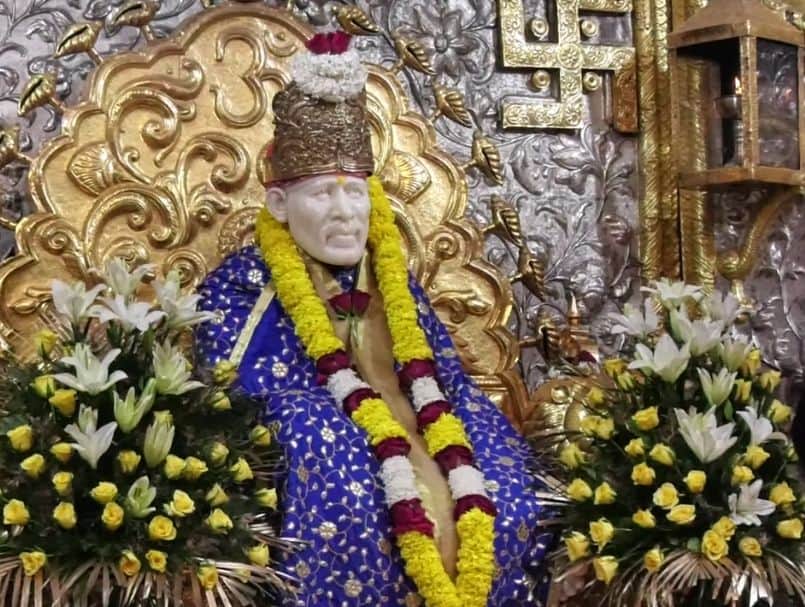
The temple itself is simple but the white marble statue of Sai Baba is magnificent, enshrined in a gold and silver carved background and surrounded by flowers. What really makes this temple unique and famous in Delhi is the devoutness of Sai Baba’s followers.
Ever since the temple was built in 1968 followers have reported feeling Baba’s divine presence and I have to agree – the spiritual energy is palpable here.
Sai Baba Mandir is especially busy on Thursdays when most followers visit.
Who is Sai Baba?
Sai Baba of Shirdi was a spiritual leader and teacher who died in 1918. The name Sai Baba comes from the Persian word for a holy person (‘sai’) and the Hindi word for father (‘baba’). He constantly tried to bring peace and understanding between the Hindu and Muslim communities.
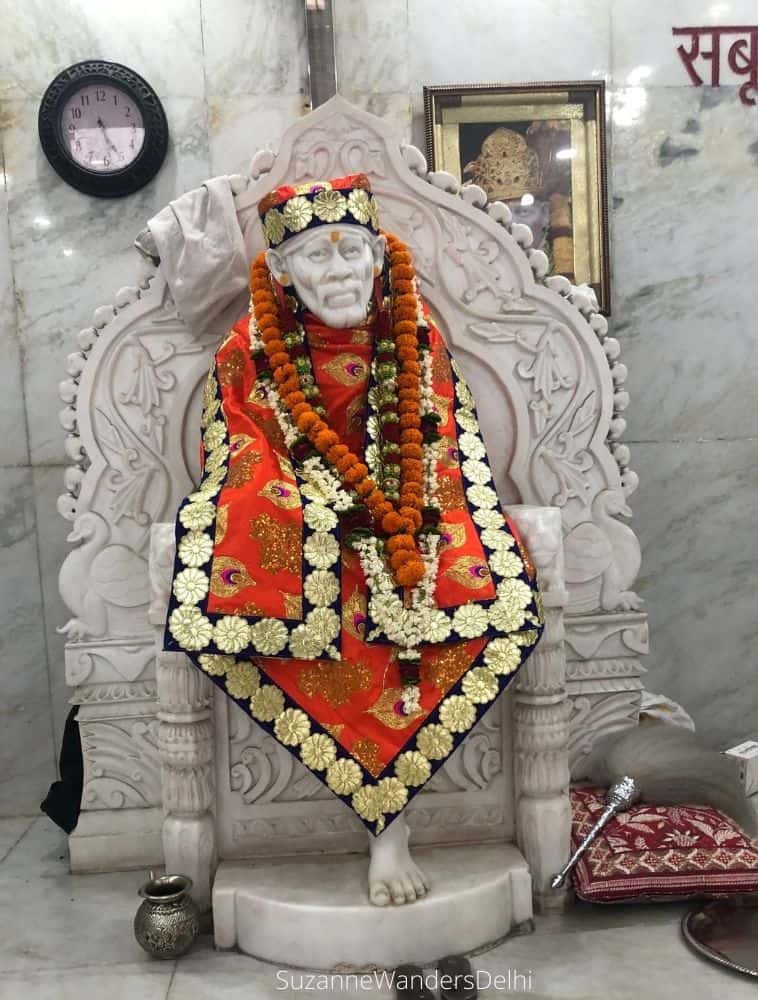
Because of his complete faith and devotion to God, his devotees believed he was a living saint. Even today, there are descendants of witnesses to the miracles Sai Baba performed.
It is not known if Sai Baba was a Muslim or a Hindu. It is believed he was born a Hindu Brahman and later adopted by a Sufi fakir (a Muslim), although Sai Baba himself claimed he had a Hindu guru. Sai Baba did not devote himself to one religion, and had many Hindu and Muslim devotees worldwide.
He had great empathy for the sick and poor and shared everything his followers gave him with the needy. The mosque where he finally took up residence was open to all, regardless of religion, caste or creed.
Sai Baba is the most popular saint in Delhi. Many Hindu temples, even those devoted to a different deity, have a Sai Baba shrine.
- Hours: 5:00 am – 10:00 pm daily (aartis at 5:30 am, 8:00 am, 12:00 pm, 6:30 pm and 9:30 pm)
- Nearest Metro Station: Jawaharlal Nehru Stadium (aka JLN Stadium) (Violet line), exit Gate 5
- What Else is Nearby: India Habitat Centre, Lodhi Garden, Lodhi Art District, Khan Market
- Where to Eat: Jamun, Habitat Hub, Habiteria Food Court
21. Shri Neelam Mata Vaishno Mandir
This temple was built as a replica of an important pilgrimage site for Hindus, the Vaishno Devi temple in the Trikuta hills of Jammu Kashmir (a state in north west India). It is dedicated to the goddess Vaishno Devi, who is an incarnation of the supreme goddess Durga.
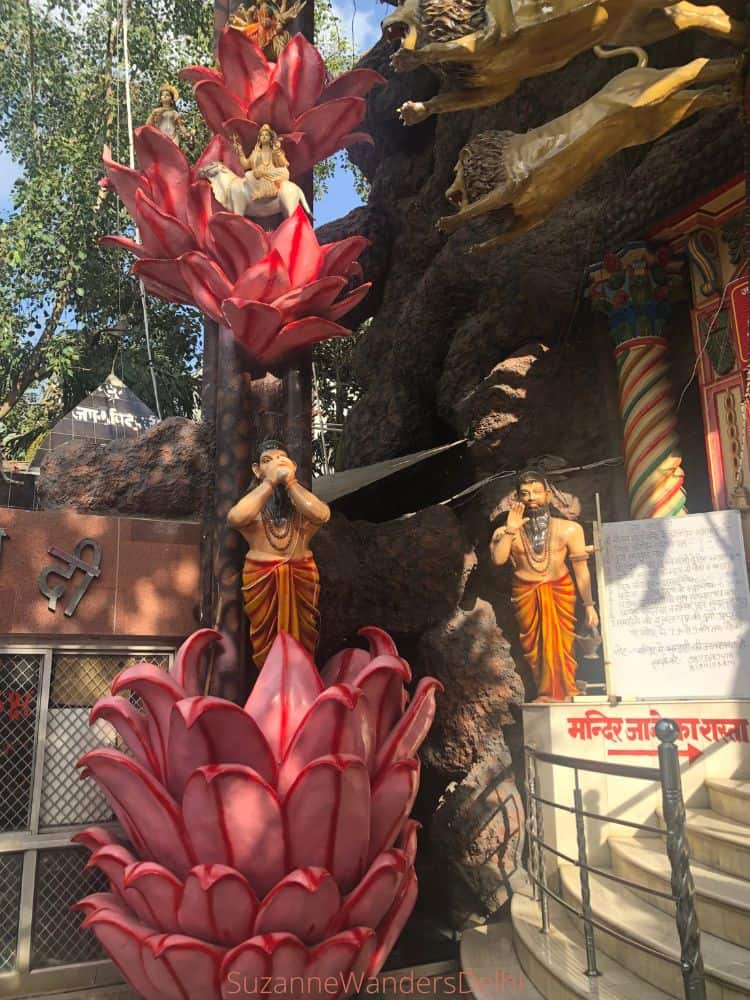
The architecture and interior of the temple is fascinating. Surrounding the temple outside are large statues of Hindu gods (Lord Shiva himself presides on the roof of the temple), the seven sages, various animals and even a winged angel. All of these represent different Hindu legends and beliefs.
Inside are several levels with many shrines and idols of Hindu deities and saints. In keeping with the original cave temple in Jammu Kashmir, the Delhi temple has a cave shrine inside the main temple which is open every evening.
- Hours: 4:00 am – 12:00 pm & 4:00 pm – 10:30 pm (summer); 5:00 am – 12:00 pm & 4:00 pm- 9:00 pm (winter)
- Nearest Metro Station: Vinod Nagar East (Pink line), exit Gate 1
- What Else is Nearby: Swaminarayan Akshardham
- Where to Eat Nearby: Cafe Junk Delhi
What You Should Wear to Visit Temples in Delhi
All temples require you to remove shoes before entering. Most will have a shoe storage area and if not, just leave your shoes outside the temple on the ground. For this reason, I recommend wearing inexpensive shoes which are easy to get on and off. I have never had a pair of shoes disappear, but it does happen occasionally.
Women and men should ensure shoulders are covered (no tank tops) and bottoms are below the knee. Some temples are more strict than others (like Swaminarayan Akshardham), but the strict ones usually have cover ups you can borrow.
Hindu temples do not require women to cover their heads, but some women prefer to. Sikh gurudwaras require everyone to cover their heads (men and women), and they have kerchiefs available to borrow for this purpose.
Be Respectful with Photos
These are places of worship, and it is considered disrespectful to take photos of a someone while praying. Some temples have strict no photography rules (like Swaminarayan Akshardham and the Bahai Lotus Temple), while others let you take as many photographs as you like. When in doubt, ask.
Temples in Delhi are Free
Temples do not charge an admission fee. However, a small donation may be left in the donation box, given to the priest, or left in front of the shrine, if you wish. This is entirely optional; INR 50-200 is appropriate.
The only exception to this is Swaminarayan Akshardham. Admission to the temple is free, but there is a small fee for the optional cultural exhibits and light and water show.
What is Prasad and What Should I Do With It?
Prasad is a devotional offering. If you visit a Hindu temple or Sikh gurudwara in Delhi, the priest may give you prasad. It can be different things, but the most common items are roses, marigold garlands, coconuts, bananas, puffed rice, and Indian sweets like ladoo or halwa.
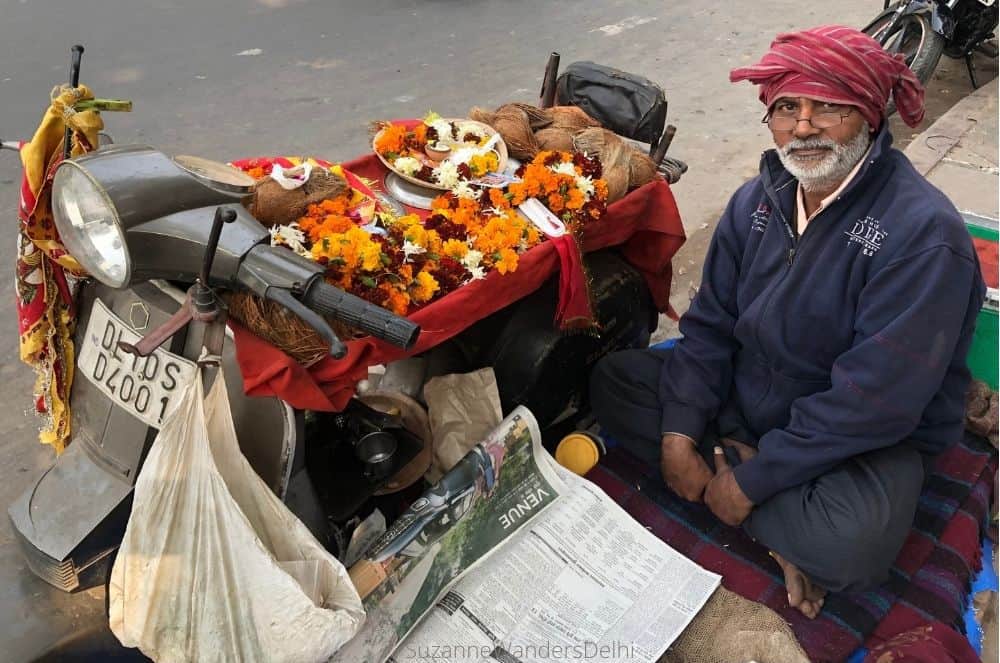
Because prasad is considered blessed by the gods, you should never throw it away.
Feel free to eat and share anything edible. Anything you do not want to eat can be given to a cow or left somewhere elevated for squirrels and birds. Whole coconuts and flowers can be left on a tree branch, or at the base of a tree if you see other prasad items left there.
Prasad items can be purchased from one of the vendors outside a temple if you wish to make your own offering. There are always stalls very close to temples which sell things like flowers, puffed rice and coconuts.
When you make an offering at a shrine, the priest will take it away so the god can partake of it. He may then bless you with a bindi on your forehead and/or tie blessed threads around your wrist.
How to Get Around Delhi
I highly recommend using the Delhi metro to get around the city. It is fast, clean, inexpensive, safe and air conditioned. It’s very easy to navigate, and operates in English and Hindi.
If your destination is not within walking distance of the nearest metro station, just take an auto rickshaw from the station to your final destination. There are always auto rickshaws outside the metro stations waiting for passengers.
The Wrap-up on 21 Famous and Unique Temples in Delhi: An Insider’s Guide
There are hundreds of temples in Delhi, but these are 21 of the most famous and unique. Feel free to visit any temple you see, visitors are always welcome. Faith is a big part of the culture of Delhi, and whether you are religious or not, visiting temples is an excellent way to experience that culture.
Don’t forget travel insurance! It’s always a good idea to carry travel insurance just in case something goes wrong. I really like and use SafetyWing

